How to Make an Awesome Objectives Slide in PowerPoint
Yousef "yoyo" abu ghaidah.
- June 13, 2018
- One Comment
Let's be honest.
How many times have you witnessed a PowerPoint objectives slide that looked so bland that you cringed?
Did it happen to look a little something like this?
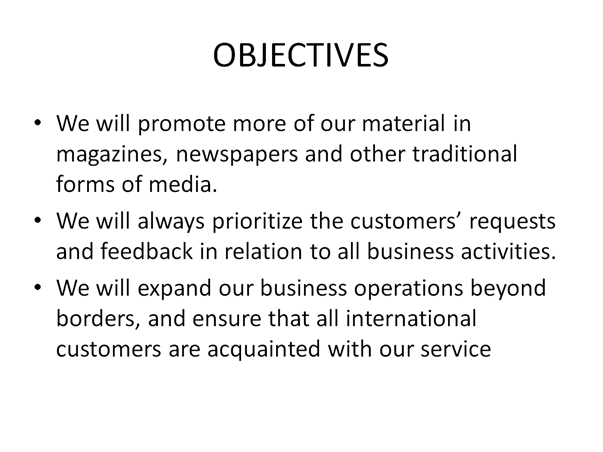
The Horror!

Presentation Objectives Matter!
Realize that a dull objectives slide will set your entire presentation up for failure .
The way I see it, the objectives slide is arguably the most important one of the lot.
Yes, it's true.
Think about it: this slide is going to be among the first things your audience is going to engage with.
On top of that, your PowerPoint objectives are practically embedded in everything you're trying to communicate!
Give your objectives slide the importance it deserves and learn how to beautifully present objectives in PowerPoint.
All you have to do is follow this tutorial, and you'll end up with a crisp, sleek, and awesome-looking slide just like the one below!
VIDEO TUTORIAL
Designing a Beautiful Objectives Slide
For your own convenience, I'll show you everything you need to do to make a stellar objectives slide in the video below. I've also summarized the steps in this post.
?Step 1: Make the Dart and Dart Board
In this step, we're going to be playing with different PowerPoint shapes to make a cool dartboard infographic for your presentation objectives.
The Dartboard
First off, bring in six circles into your PowerPoint slide (it doesn't matter where, or how big they are; we'll fix all that up later).
Resize each circle making one circle larger than the last one. To do this, click on one of your six circles, then go to Format . In the Size box, make your first circle with a height and width of 1cm (0.39 inches)
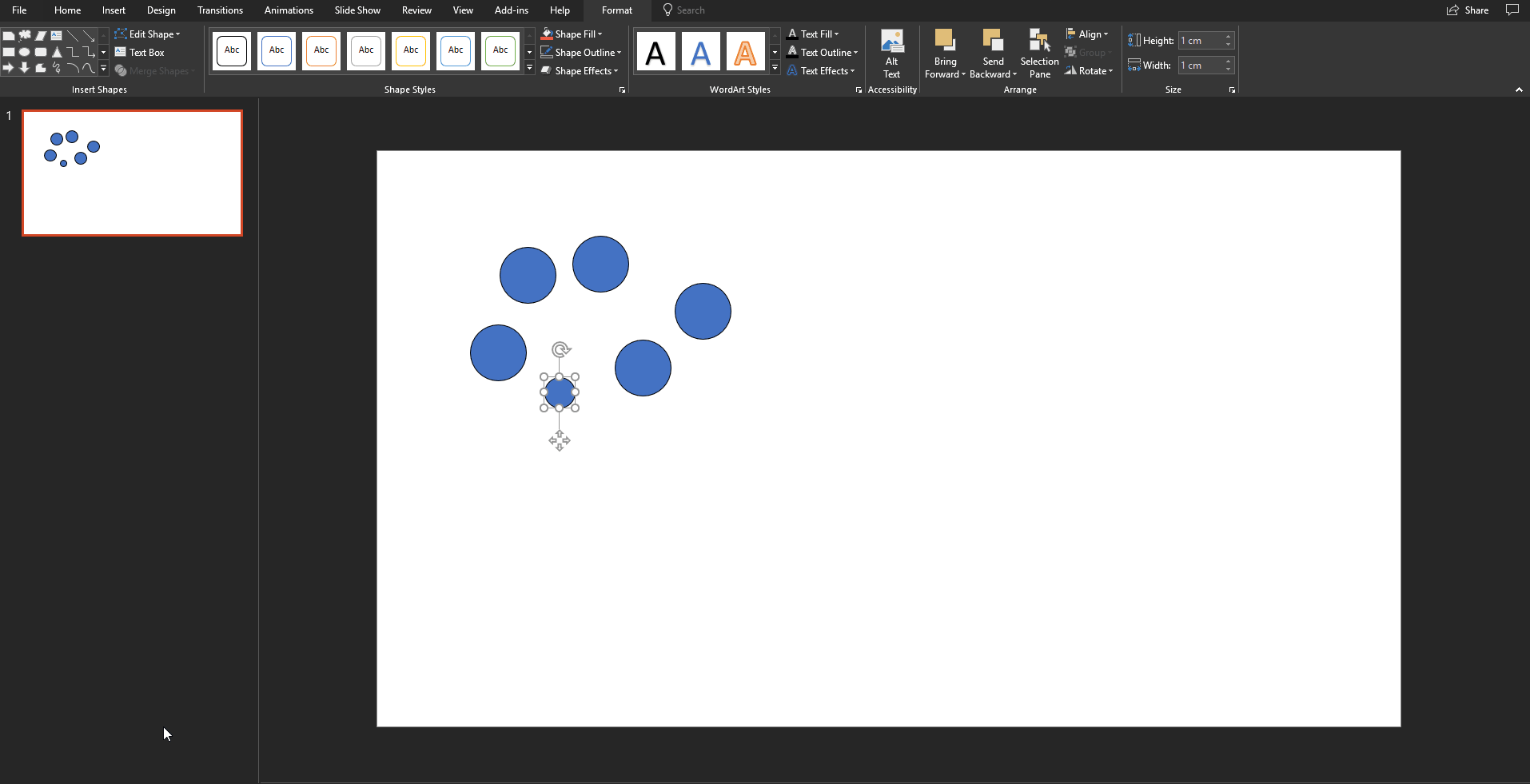
Go ahead and set another circle's height and width to 2cm (0.78 in inches). Follow this pattern and do this with every circle (3cm (1.17 inches), 4cm (1.56 inches), etc.) .

Now stack your circles in a way that shows it goes from smallest to biggest. To do this, you have to play around with PowerPoint's Arrange and Alignment Features . If you need guidance on this, just refer to the video.
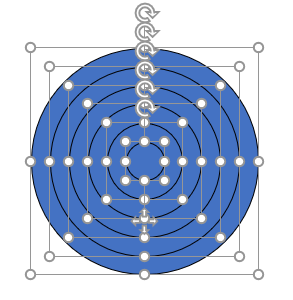
Go ahead and fill in your circles with different colors sequentially so you get a dartboard infographic.

You'll need to bring in three shapes into your PowerPoint slide: one rectangle with rounded corners, and two parallelograms.
Position them to look like a dart, just like the picture below.

Bring It All Together
Rotate your dart and stick it in the middle of your dartboard. You should end up with something like the image below.

Hurray! The hard part's done! You now have a dartboard infographic that goes well with your presentation objectives.
Step 2: Set up Your Objectives Slide
We're going to use a rectangle to set up the layout of the slide. Draw one out so that the width takes over the entire slide, but just be sure to keep the height short.
Now, place the dartboard on the left side of the slide, and keep your rectangle behind it.
After that, bring in a title for your objectives slide. Keep it short, sweet and noticeable.
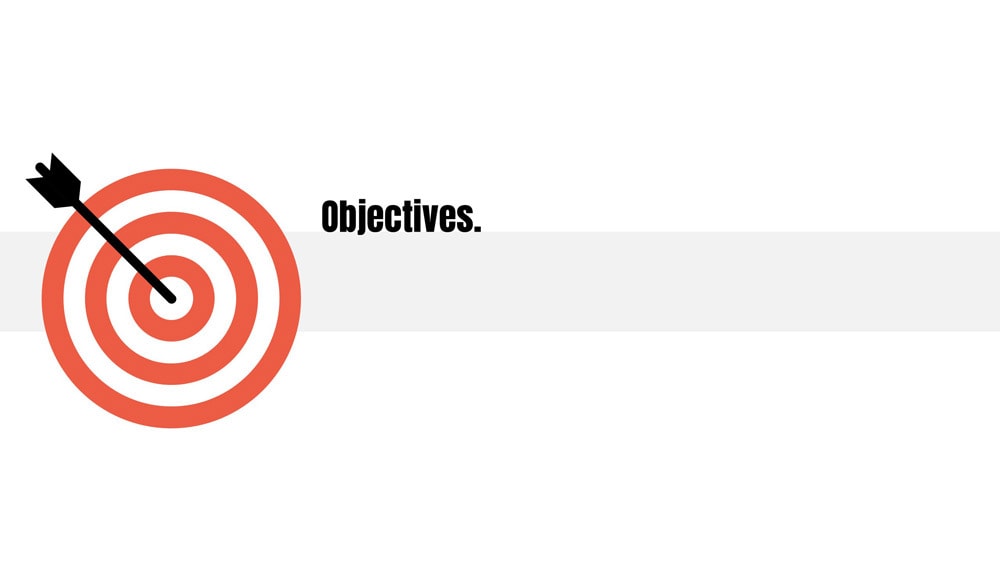
Step 3: Bring in Your First Objective
To do this step, you're going to need some icons that represent what your first objective is about. If you're unfamiliar with how to do this, then check out Slide Cow's PowerPoint icon guide that will teach you three ways to bring in any icon you want into your slide.
Once you've brought in the icon you want, place it in the rectangle you made in the second step.
Underneath your icon, add a heading and some text that best explains your objective in a presentation setting . For best practice, I suggest following the SMART principle .
It's important to align everything to the left here because it focuses on the strategy of the slide . That is, we want the audience to read everything from left-to-right, so that everything's sequential.
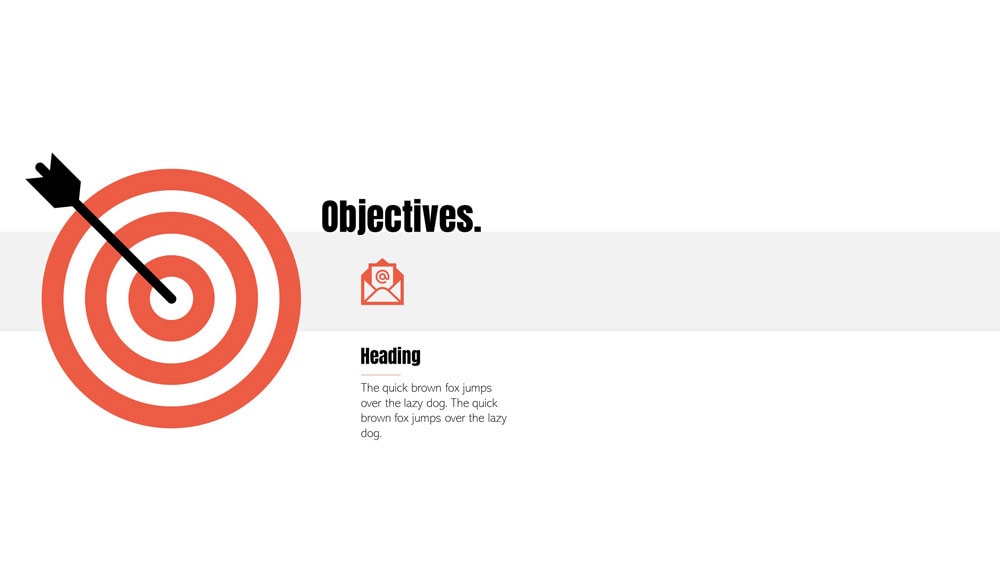
Step 4: Replicate and Modify
Group up the elements that make up your first objective (the icon, heading, and text) and duplicate it. Keep duplicating until you have enough elements to capture your message in full. For example, if you have three objectives, then duplicate your first objective twice.
You're all set to modify each duplicated group to describe your other objectives. Keep it short and simple . Also, make sure everything is appropriately aligned and positioned.
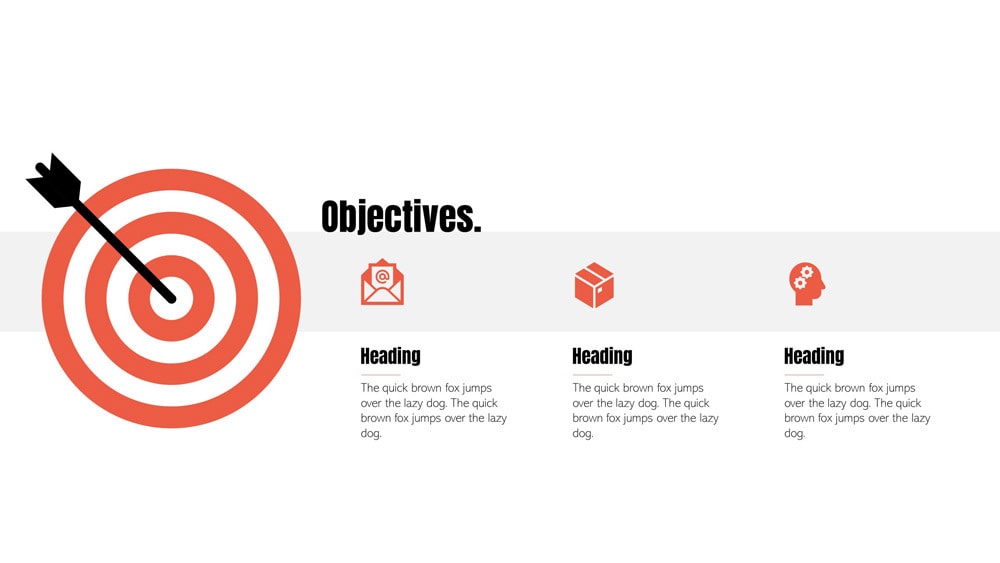
Easy Peasy!
Designing PowerPoint objectives can be tricky, but hard work pays off ! With a slide like this, you're sure to set your presentation on the right track from the get-go. Promise!
If you have any issues, just leave a comment below and I'll get back to you.
i could not understand what are slide layouts in microsoft power point and explain the slide page layouts and explain the animation effects and slide objectives
Got a project for us?
© Slide Cow. All rights reserved.
Session expired
Please log in again. The login page will open in a new tab. After logging in you can close it and return to this page.

Researched by Consultants from Top-Tier Management Companies

Powerpoint Templates
Icon Bundle
Kpi Dashboard
Professional
Business Plans
Swot Analysis
Gantt Chart
Business Proposal
Marketing Plan
Project Management
Business Case
Business Model
Cyber Security
Business PPT
Digital Marketing
Digital Transformation
Human Resources
Product Management
Artificial Intelligence
Company Profile
Acknowledgement PPT
PPT Presentation
Reports Brochures
One Page Pitch
Interview PPT
All Categories
Top 10 Objectives Slide Templates with Examples and Samples
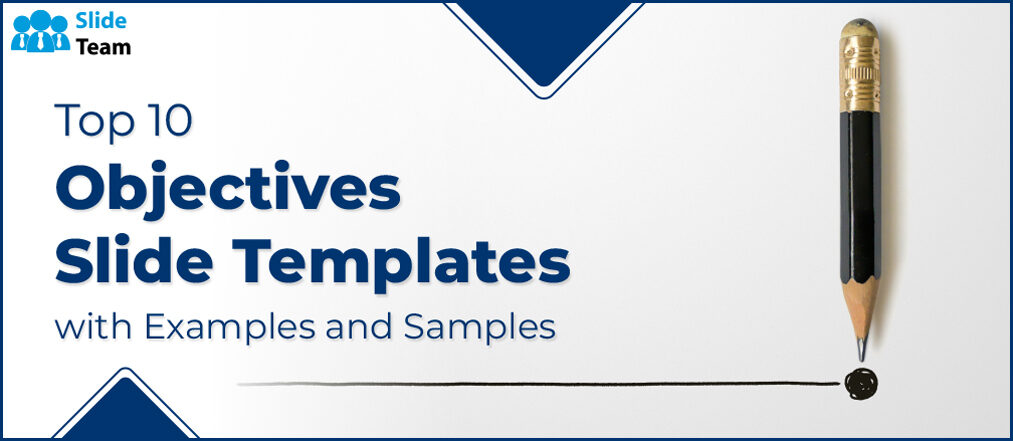
Tejas Prasanna
A successful business venture depends on the objectives you want to achieve. Clear and well-defined objectives have the qualities of sensible, relevant, specific, time-bound, quantifiable, and within the realms of achievement, even as these involve some stretch from all stakeholders in the organization.
Setting goals, however, requires lots of planning and taking small actions to greater achievements. Above all, you will also need to monitor how your action plans are doing and whether you are on the path toward achieving your business objectives.
You can use tools for this process, including worksheets, traditional calendars, pen and paper, or online tools.
At SlideTeam, we offer handy, readymade PowerPoint Presentation Slides. These slides on objectives helps you set and achieve verifiable progress like 15% increase in revenue in a quarter, and so on.
Even better, each of these templates is 100% editable and customizable. You get structure and flexibility both, and can tailor the presentation to unique audience profile.
Also, explore our goals and objectives templates with a click here !
Let’s explore our slides on objectives below.
Template 1 Objectives slide pitch deck PPT Presentation
This PPT Template pitch deck serves as a tool to assess your company's willingness and attitude toward change. With this template, you can gauge your employees' skill level and performance. Use this slide to monitor two aspects: Your firm’s progress and yearly milestones, such as product development or application optimization. Set and achieve goals for your organization and emerge on top.
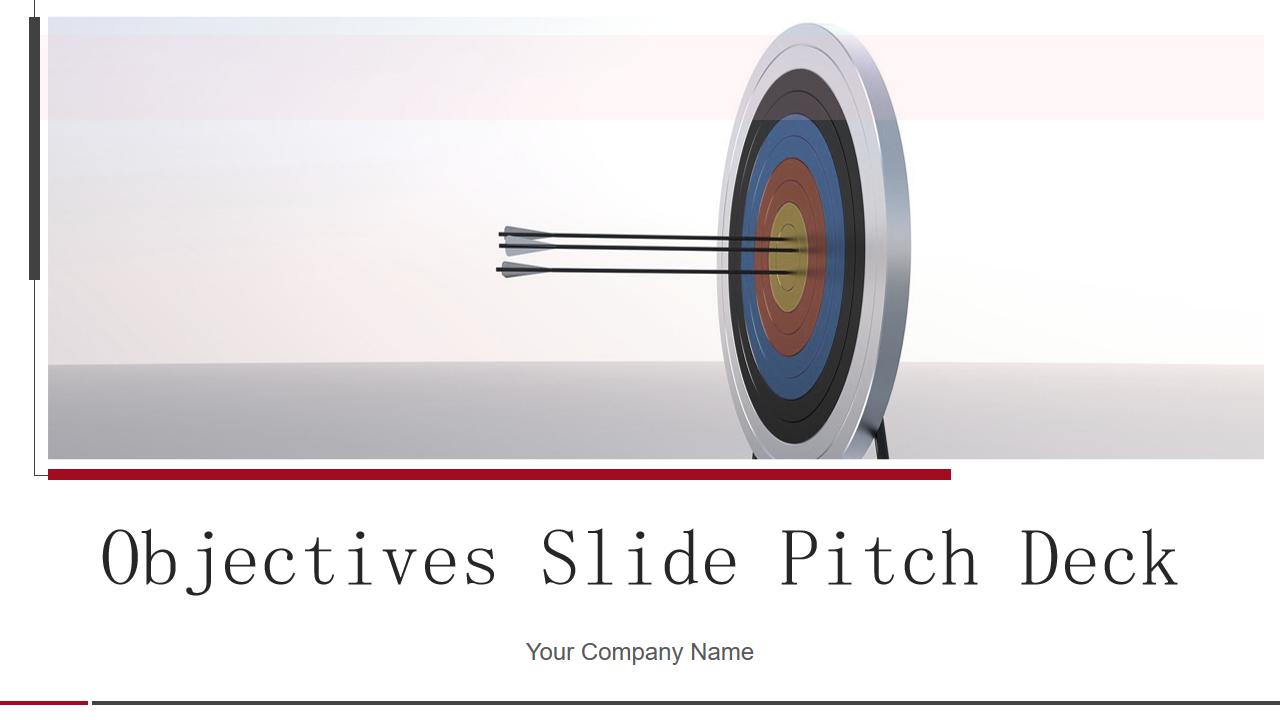
Download now!
Template 2 - Goals Objectives Strategies: Company Objectives Goals Strategies Measures
This PPT depicts your strategies and business objectives. It also lets you measure those strategies and change them as required. The template comprises a business framework that defines strategies that help achieve business and organizational objectives and suggests measuring their effectiveness. You can also adopt business models that align with these strategies. Specify your vision, the goals you want to achieve, and the plan you want to use.
A company model that defines your business objectives, a means to measure your business goals and strategies, customer awareness, and buyer journeys are among the other essential elements of this template. The slide on understanding objective-driven, performance-based company structure maps four major business goals to objectives. These four goals are increased awareness, drive conversions, generate conversion and build customer loyalty.
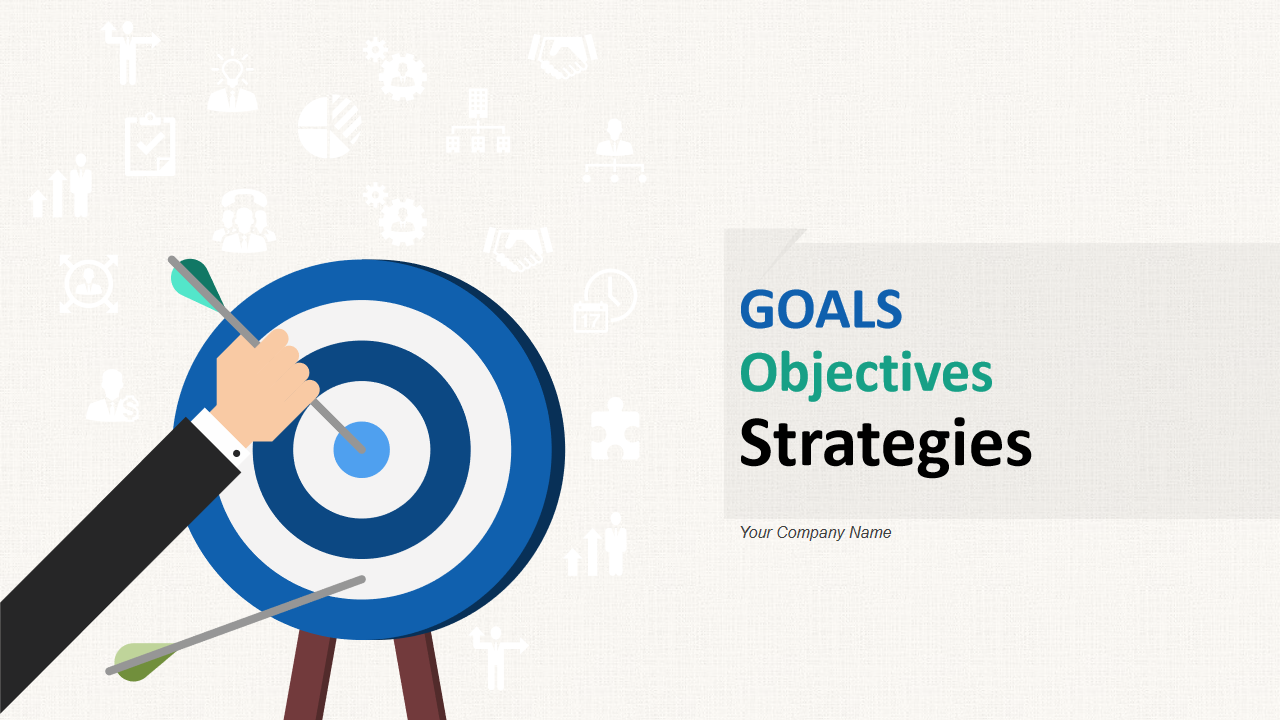
Get it now!
Template 3 - Aims and Objectives Relevant Business Plan Planning Process Requirement
Use this PPT Template to define specific, measurable, actionable, relevant, and time-bound objectives. Also, chart your aims and objectives and ensure they align with your business strategies. Use the objectives planning triangle to specify an overall purpose, specific aims, and objectives, or the process flow, to create roadmaps to achieve your goals. Business aims and objectives worksheet, case study, formation, hierarchy, and setting objectives for your business are also covered.
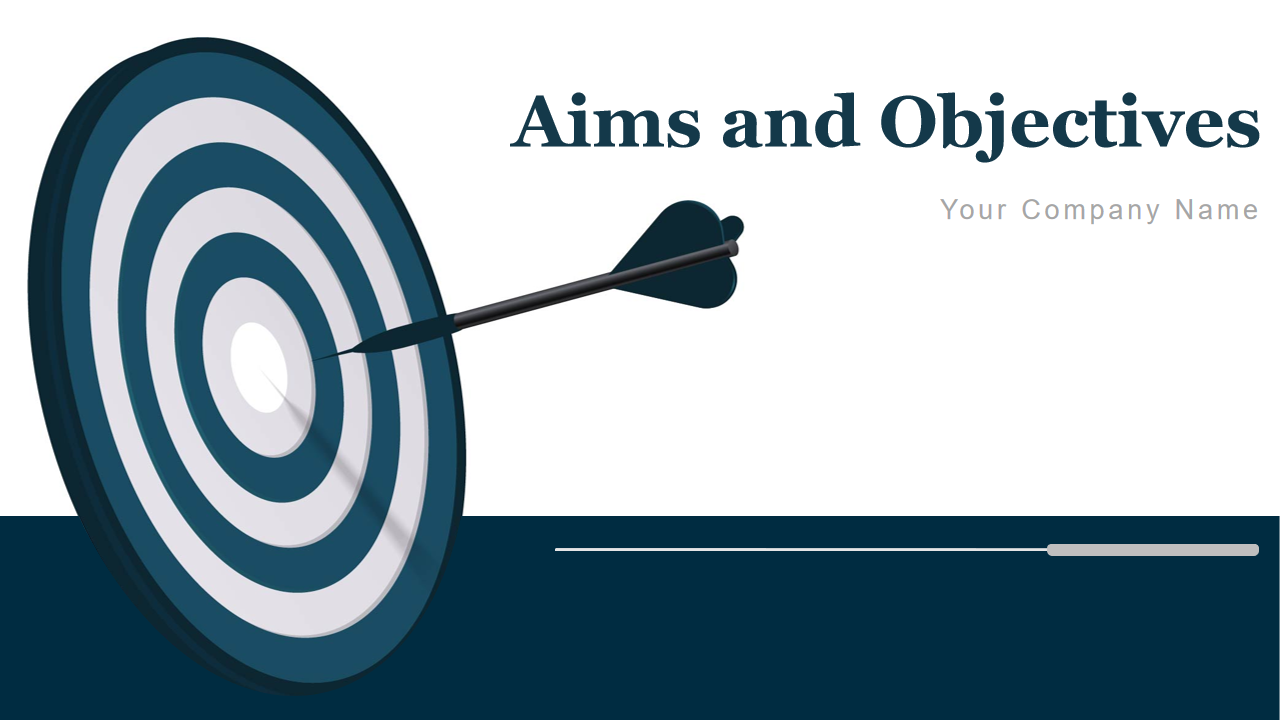
Download today!
Template 4 - Media objectives example of PPT presentation
The template depicts objectives relevant to media organizations, such as values, communication, satisfaction, product, and engagement. As a media organization, you must stand true to your values. You must also be able to communicate your goals and objectives and ensure your customers are happy with your offerings. Use this presentation template to engage more with your customers through your brands and products.
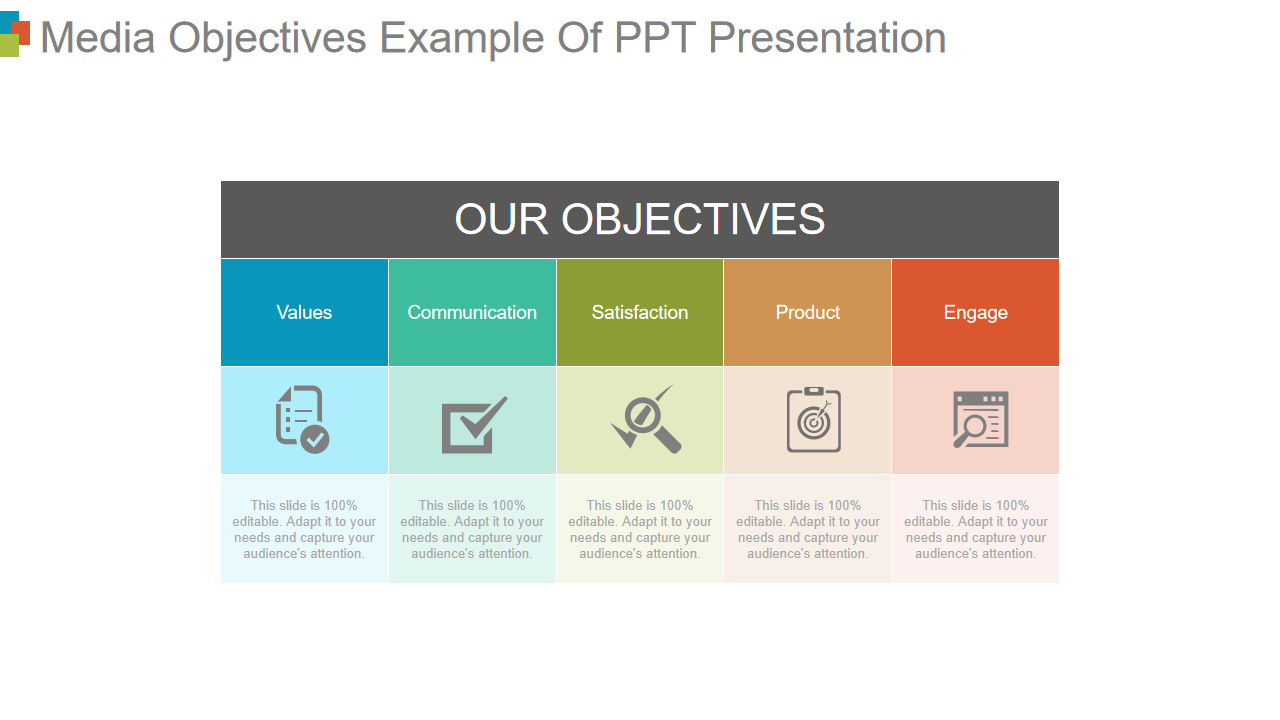
Get it today!
Template 5 - Project review with cost objectives, status accomplishments changes
This PPT Template lets you state your project goals and objectives, what you will gain, what is the total cost of the project, who are the stakeholders, and what are the challenges and risks. You can also set a strict timeline for the project and ensure you stick to it. The presentation comes with indicators that can help track your projects. For instance, 'G' represents that you are on track, whereas 'N' means the project hasn’t begun yet. This tool is an efficient project tracker; get it now!
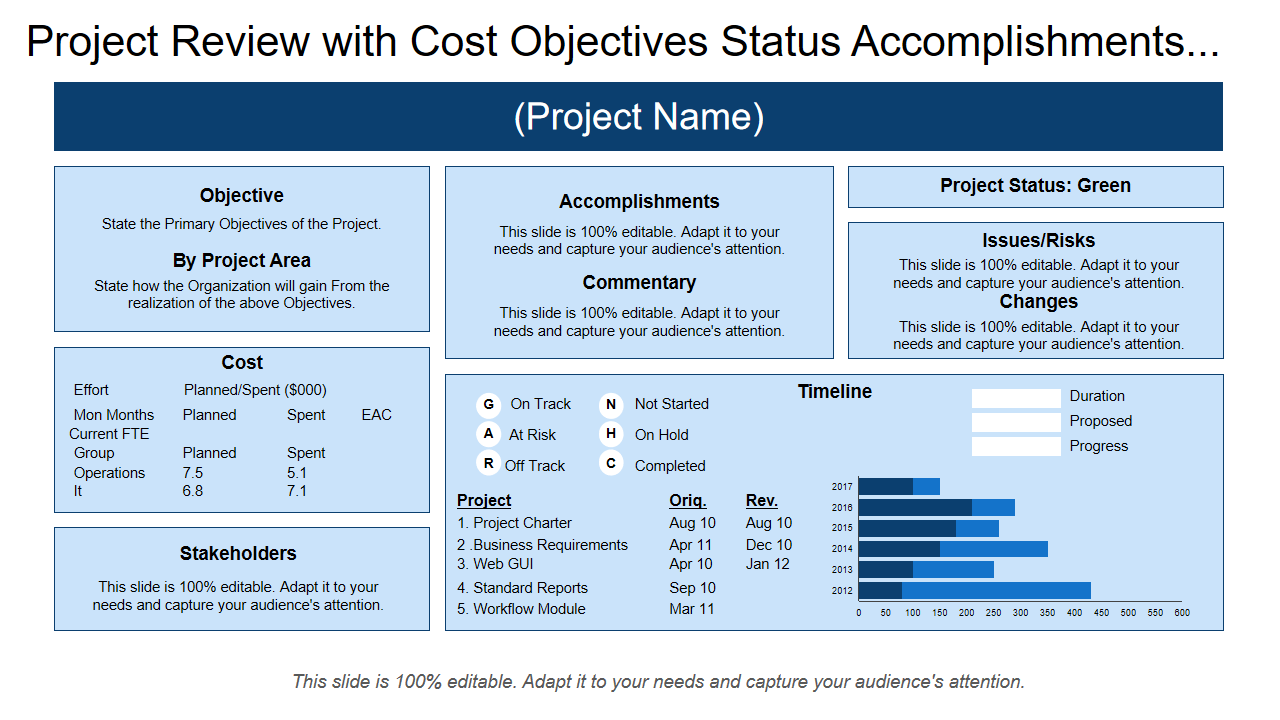
Download this template now!
Template 6 Business objectives optimize operations and infrastructure with icons
Optimize your business operations and infrastructure with this handy PPT Template. The slide lets you streamline business processes and optimize operations and infrastructure. It can also help simplify your services and improve the product, and related customer experience. Meet all your business objectives with this slide, be it streamlining your business by optimizing infrastructure or delivering a better product and consumer experience.
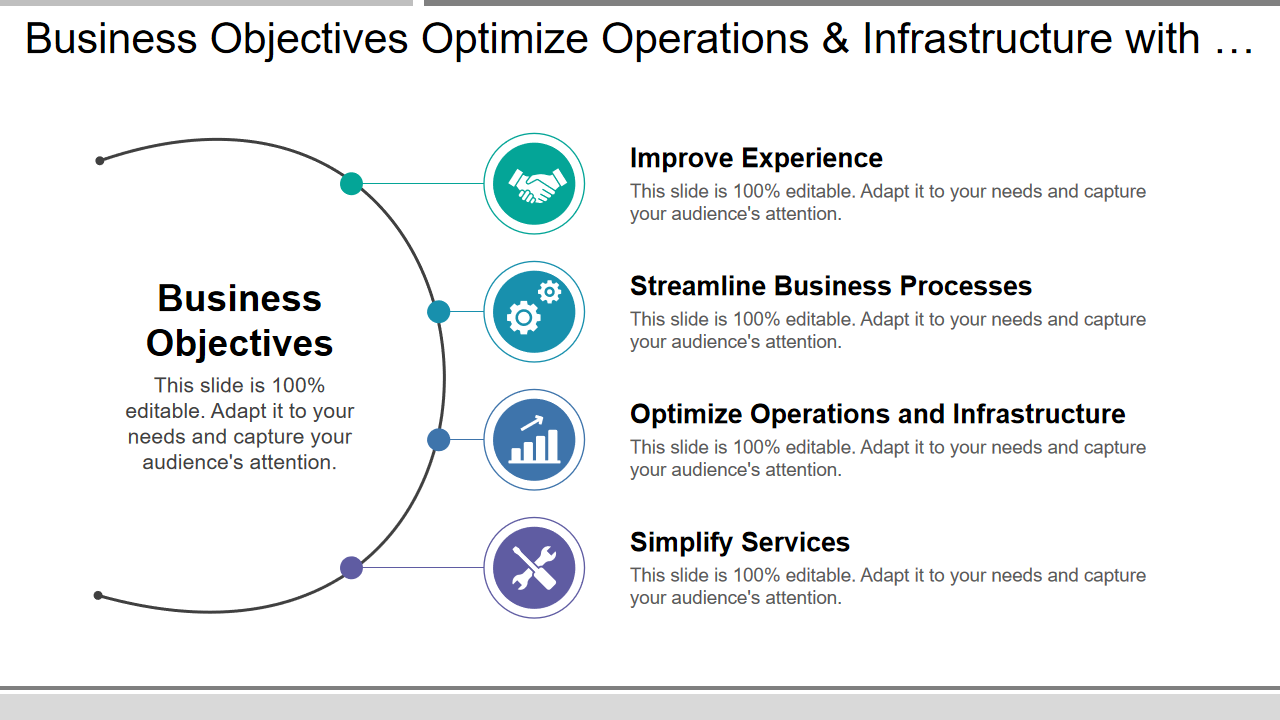
Get this template now!
Template 7 - Smart objectives slide
Create and achieve SMART objectives with this slide. Objectives must be specific, meaning that your goals must be clear. Second, they must be achievable. That is, your goals must be attainable within a clearly defined timespan. Your goals must also be relevant to your business or company and time-bound. That means you must be able to achieve your business objectives within a well-defined timeframe. So, set smart goals and work hard towards achieving your business objectives.
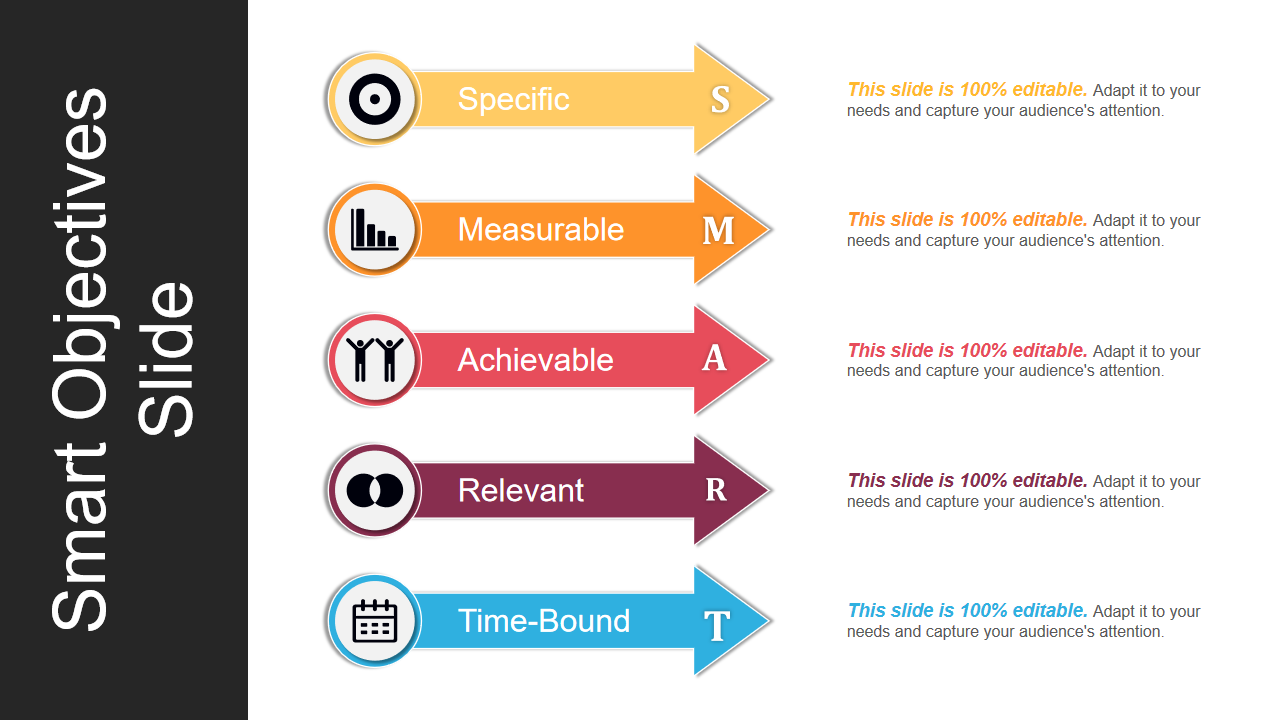
Download this template today!
Template 8 Performance objectives PPT model
You may have fixed assets, or you may be working with capital. However, you will still need to track how your assets are doing and determine how they can help achieve your business objectives. Performance indicators for these assets could include turnovers or average revenues. You can track them all with this presentation.
The template also lets you track the total value of the assets that you have with you and your working capital.
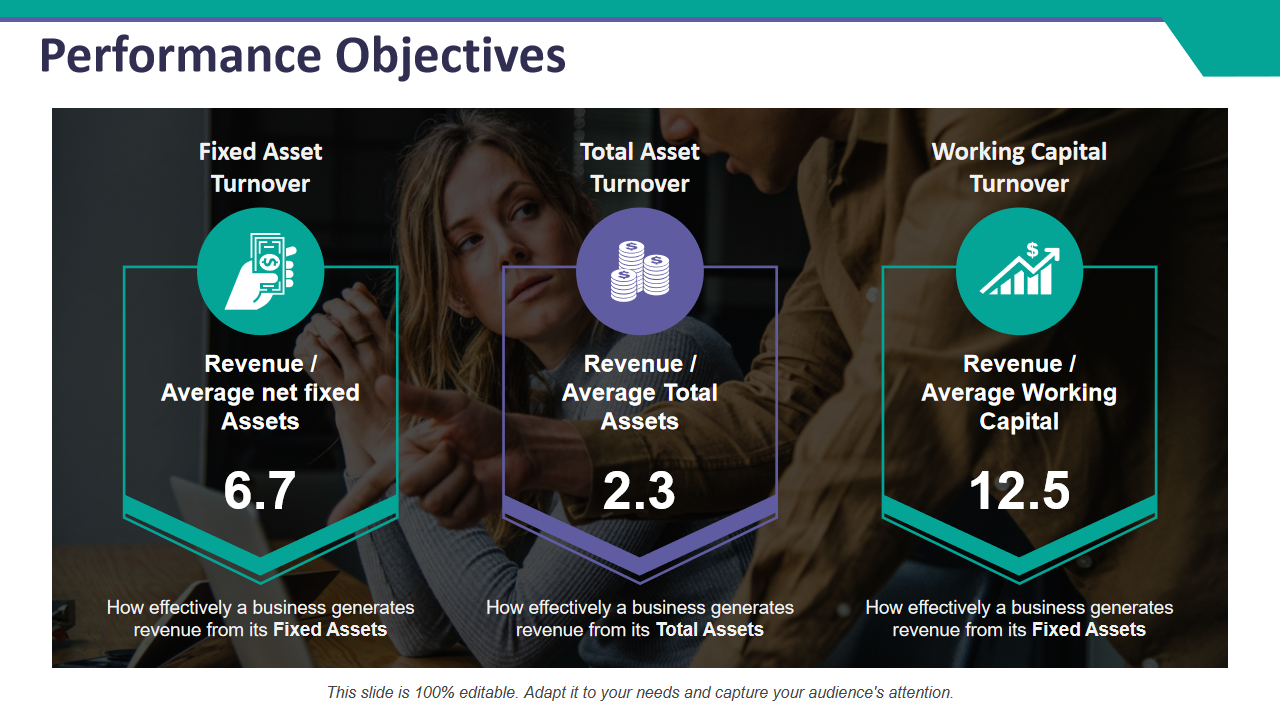
Get this template today!
Template 9 - Multistep new business development process map with summary objectives
Map out each stage of the business development process with this template. Set a timeframe and focus on your customers. Use the summary objective to summarize what you will do in each stage. For instance, you could identify new opportunities and develop long-term customer relationships within a month or two. Similarly, with a full understanding of your customers and their preferences, you could select potential prospects that can help your business grow manifold in three to six months. Map out each step of the business development process with this presentation template now.
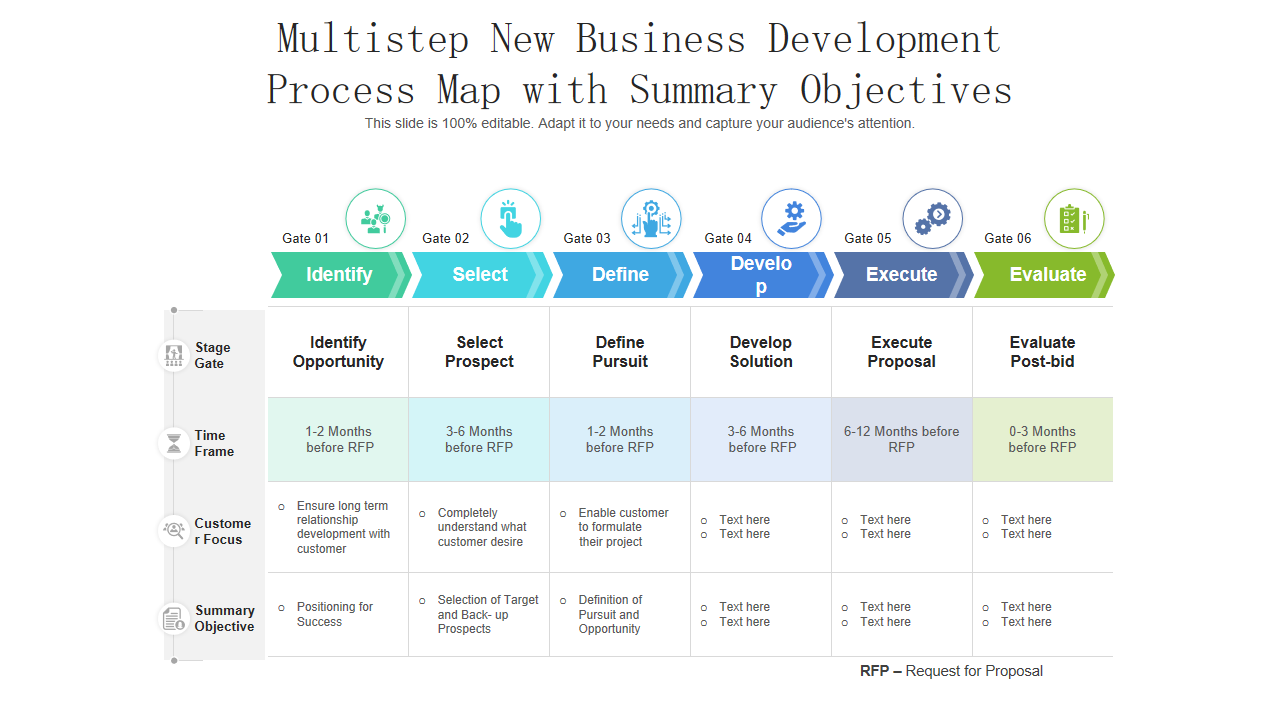
Download this presentation now!
Template 10 - Target Objectives PowerPoint PPT Template Bundles
Achieve your business objectives by setting relevant and achievable targets. You get types of targets in this slide that can help meet your business objectives. Examples include the business strategy scorecard with key and source targets or the company-weighted goals with target performance levels. Organization target objectives with action plans, vital financial objectives with target status, and sales and marketing target objectives for business growth are other notable features of this presentation template.
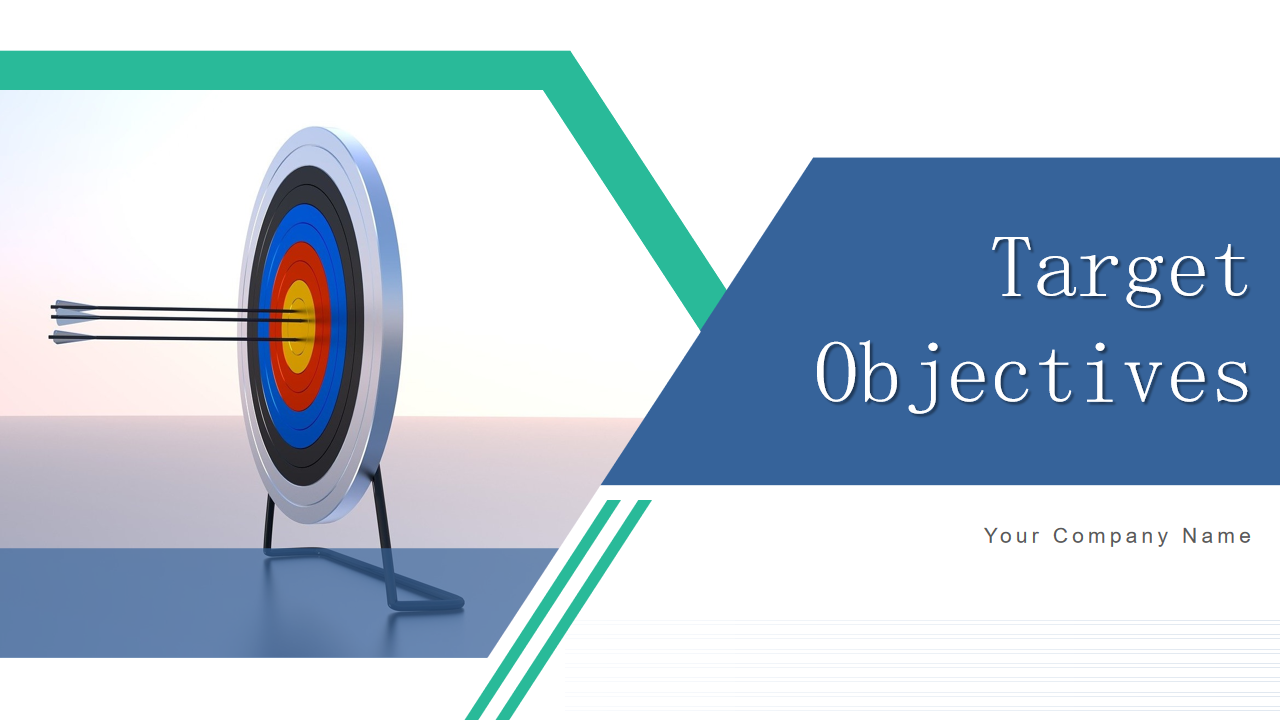
Get this presentation now!
MEET YOUR TARGETS AND OBJECTIVES WELL
These templates are a great way to create and achieve your objectives, be it business, organizational, or any other purpose. Use these to let your target audience know how they can achieve their business goals. The slides have compelling visuals, charts, and infographics; you can use them to explain to customers your business objectives and how you plan to meet your targets. Don’t forget to use these presentation slides to achieve your business objectives.
Quality is also a key business objective. Check out our must-have quality objective templates here .
PS If you are looking for and objectives and key results – OKR templates, please click here !
FAQs on Objectives
What is an objective slide.
Objective slides are PowerPoint Presentations that let you know about specific goals or objectives. They usually appear at the beginning and act as an orientation for the audience by setting expectations. These are important as how they are defined can be pathbreaking or scuttle deals, if poorly presented or executed.
What is an example of an objective?
Let's say that you want to give a presentation on clothing. Your goal here may be to urge your audience to buy your brands or certain types of clothing. Similarly, if your presentation is on dental health, your objective could be to stress the importance of brushing your teeth regularly and keeping them clean.
What are the types of objectives?
There are three types of objectives: process, behavioral, and community-level outcome. Process objectives form the foundation for the implementations required for achieving your goals. Behavioral purposes look at what people do and say and how they do it. These objectives define behavioral patterns and changes. For example, the objectives for a neighborhood improvement group would be increased home repairs that could help the locality have fewer broken windows.
Community-level objectives, however, focus on the results of behaviors rather than on the behaviors themselves. In the above example, community-level outcome objectives could be having more people come and live in that neighborhood and, consequently, focus on building more houses.
Related posts:
- 4 Must-have Process Objectives Examples with Samples and Templates
- Top 10 Goals and Objectives Templates with Samples and Examples
- Top 10 Business Goals Templates with Examples and Samples
- Top 7 Marketing Objectives Templates with Examples and Samples
Liked this blog? Please recommend us

Top 10 Design Project Proposal Templates with Examples and Samples

Top 10 Management Proposal Templates with Examples and Samples
This form is protected by reCAPTCHA - the Google Privacy Policy and Terms of Service apply.

Digital revolution powerpoint presentation slides

Sales funnel results presentation layouts
3d men joinning circular jigsaw puzzles ppt graphics icons

Business Strategic Planning Template For Organizations Powerpoint Presentation Slides

Future plan powerpoint template slide

Project Management Team Powerpoint Presentation Slides

Brand marketing powerpoint presentation slides

Launching a new service powerpoint presentation with slides go to market

Agenda powerpoint slide show

Four key metrics donut chart with percentage

Engineering and technology ppt inspiration example introduction continuous process improvement

Meet our team representing in circular format


How to Make an Objectives Slide in PowerPoint
Last updated on September 25th, 2023
An engaging presentation starts with clear, compelling objectives. In any presentation, the objectives slide sets the stage by establishing what you intend to accomplish and how you plan to do so. When designed well, this slide provides the audience with a roadmap of what they can expect, which in turn enhances comprehension and engagement. If you’re searching for ways to design a riveting objectives slide in PowerPoint, you’ve come to the right place! Let’s dive into a step-by-step guide that will help you transform your objectives slide into an attention-grabbing part of your presentation.
Understanding Objectives in a Presentation: What is an Objective in a Presentation?
Before diving into creating an objectives slide, it’s crucial to understand what exactly an objective in a presentation means. So, what is an objective in a presentation? An objective is a clear and specific statement that describes what you want to achieve by the end of your presentation. An objective in a presentation outlines the primary takeaway or the core message you want your audience to grasp. In essence, it sets the direction for the entire presentation, ensuring that both the presenter and the audience have a clear path to follow. It acts as a guiding star, ensuring that your content stays focused and relevant to what you intend to convey. Additionally, having a well-defined and effective objective increases the chances of your presentation achieving its desired outcome, whether it’s imparting knowledge, persuading the audience, or driving action, depending on the type of presentation you are making.
Step 1: Define Your Objectives
The first step in creating an objectives slide is to clarify your objectives. What are the key points you want to convey to your audience? Remember, objectives should be specific, measurable, achievable, relevant, and time-bound ( SMART Goals ). This ensures that your presentation has a clear purpose that is both understandable and actionable.
Step 2: Select a Suitable Layout for the Objectives Slide
PowerPoint offers a range of layout options suitable for an objectives slide. If you have numerous objectives, you might want to use a bulleted list or a grid layout.
Alternatively, for fewer objectives, you might consider using a PowerPoint graphic, such as a pie chart or pyramid diagram, to make the slide more visually appealing.
Step 3: Write Your Objectives
Once you’ve chosen a layout, it’s time to write your objectives. Ensure your objectives are concise and clear, each expressed in one short sentence. Avoid jargon and use language that your audience can easily understand.
Apply the rule of three : aim to articulate no more than three key points per slide. This approach ensures your information is digestible and retains the audience’s attention. Be concise and clear with each objective, encapsulating the point in one short sentence. Avoid using industry jargon and opt for language that your audience can easily understand. The goal here is clarity and simplicity, allowing your audience to grasp the main objectives swiftly.
Step 4: Design Your Slide
Now that you have your objectives and a layout, it’s time to design your slide. Incorporate your brand’s colors and fonts to create a consistent visual theme. Use images or icons sparingly to support your objectives, not to distract from them. A visual representation of a goal is typically using a Goal graphic like the image below.
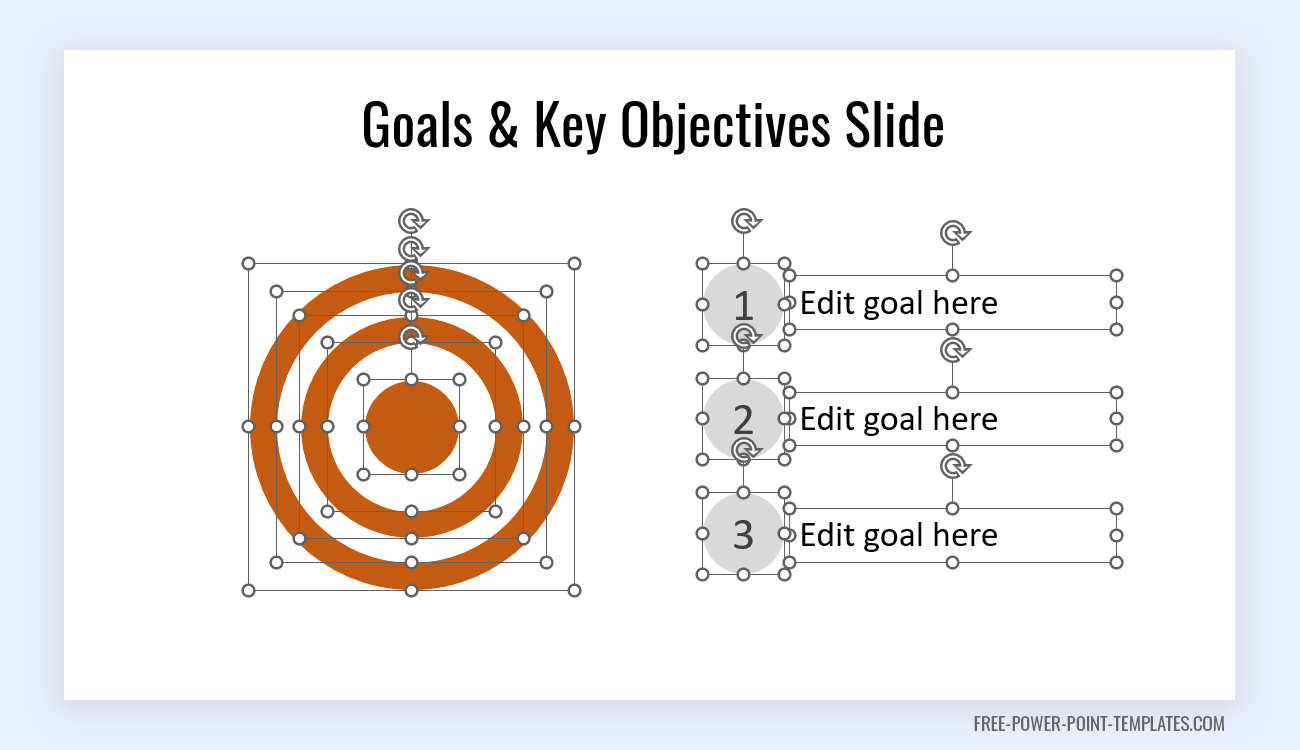
How to design your slides in PowerPoint?
A possible way to design your slide is by creating a Goals shape in PowerPoint using the dart & dart board metaphor and analogy.
For this purpose, you can make concentric circles and align them to the center (vertically and horizontally). Then, you can change the fill color for some of the inner circles to produce what is shown in the image above.
Additionally, ensure your text is large enough to be easily read by all audience members.
Use pre-made Goals & Key Objectives Slides for PowerPoint and Google Slides
Alternatively, you can download pre-made slide templates, like the best targeting goals & key objective slides for PowerPoint and Google Slides from free websites like this one, or a goals PPT template from sites like SlideModel.
The example below shows an editable goals template with placeholders to enter up to 6 goals, this example is brought to you by SlideModel. The examples uses a Dart and Dart Board to illustrate the objectives.

Step 5: Review and Edit
The final step is to review and edit your slide. Look for any spelling or grammatical errors, and make sure that all your objectives are clear and consistent with your overall presentation’s theme. Ask a colleague or friend to review the slide to catch any errors you might have missed and to provide feedback on its overall clarity and visual appeal.
Use Cases and Applications
PowerPoint’s versatility makes it the perfect tool for creating objectives slides for various occasions.
- Business Presentations : When presenting a new project, initiative, or strategic plan, an objectives slide can clearly articulate your goals and the steps to achieve them.
- Educational Lectures : Teachers can use an objectives slide to outline what students should learn by the end of a lecture or course.
- Conference Talks : Speakers at conferences can use an objectives slide to set expectations and highlight key takeaways for their audience.
- Sales Pitches : Salespeople can utilize an objectives slide to summarize the benefits of their product or service and the goals of their pitch.
If you are curious on what are possible ways to present goals & target slides in presentations, check out the best targeting & goals slide templates for PowerPoint & Google Slides.
A well-crafted objectives slide can significantly elevate the effectiveness of your PowerPoint presentation. By clearly defining your objectives, choosing an appropriate layout, writing clear and concise objectives, designing an engaging slide, and carefully reviewing your work, you can create an objectives slide that effectively communicates your message and enhances audience engagement. Whether you’re a business professional, an educator, a conference speaker, or a salesperson, these steps can help you create a compelling objectives slide for your next PowerPoint presentation.
Leave a Comment Cancel reply
Your email address will not be published. Required fields are marked *
Save my name, email, and website in this browser for the next time I comment.
Sign up to our newsletter
We will send you our curated collections to your email weekly. No spam, promise!
How to Write Content Objectives in PowerPoint: A Step-by-Step Guide
Writing content objectives in PowerPoint involves defining the goals of your presentation and what you hope your audience will learn or achieve by the end. It sets the stage for your entire presentation and provides clear direction for both you and your audience. In a few simple steps, you can craft effective content objectives that will strengthen your PowerPoint presentation.
After completing your content objectives, you’ll have a clear set of goals to guide your presentation. This not only helps you stay focused but also gives your audience a roadmap of what to expect. It enhances the effectiveness of your communication and ensures that your key messages are understood and remembered.
Introduction
When it comes to presenting information, whether it’s in a classroom, business meeting, or conference, clarity is king. One way to achieve this is by setting content objectives in your PowerPoint presentation. But what are content objectives, and why are they so crucial? Content objectives are specific targets that you set for your presentation to outline what you want your audience to learn or understand by the end. Think of them as the destination you want your audience to reach by the end of your journey together.
Why is this important, you ask? Well, have you ever sat through a presentation and walked out thinking, “What was the point of all that?” That’s what happens when content objectives are missing or unclear. Not only does it leave your audience confused, but it also makes your presentation seem unstructured and ineffective. Whether you’re a teacher, a business professional, or anyone else who uses PowerPoint, setting clear content objectives is an essential step to ensure that your presentation hits the mark every time.
Step by Step Tutorial on How to Write Content Objectives in PowerPoint
This section will provide you with clear steps to create and integrate content objectives into your PowerPoint presentation to make it more goal-oriented and focused.
Step 1: Identify the main topic of your presentation
Begin by clearly defining the central theme or subject of your presentation.
Knowing the main topic of your PowerPoint presentation is crucial as it lays the foundation for your content objectives. It’s like knowing what you want to cook before you start gathering ingredients. Once you have a clear topic in mind, you can start thinking about what specific aspects you want your audience to understand or learn about this topic.
Step 2: Determine what your audience should learn or achieve
Decide on the key takeaways or goals that you want your audience to walk away with after your presentation.
This step is all about putting yourself in your audience’s shoes. What do they need to know? What would be valuable for them to learn? It’s not just about what you want to tell them, but what they should remember. This will help you craft content objectives that resonate with your audience and provide real value.
Step 3: Write your objectives in a clear, concise manner
Articulate your content objectives in a way that is easy to understand and remember.
The way you write your objectives can make a big difference. They should be brief, to the point, and devoid of any jargon that might confuse your audience. Think of them as signposts along the road, guiding your audience to the final destination of your presentation.
Additional Information
Crafting content objectives in PowerPoint is not just about ticking a box; it’s about enhancing the overall impact of your presentation. It’s essential to strike a balance between being clear and being engaging. Your objectives should be like a promise to your audience, one that you fulfill as you take them through your slides.
Remember, objectives are not just statements; they are commitments to delivering value. So, it’s crucial to ensure that your content objectives align with the content of your slides. Consistency is key. You wouldn’t want to promise a thrilling adventure only to take your audience on a leisurely stroll, would you?
- Identify the main topic of your presentation.
- Determine what your audience should learn or achieve.
- Write your objectives in a clear, concise manner.
Frequently Asked Questions
How detailed should content objectives be.
Content objectives should be specific enough to provide direction but not so detailed that they become cumbersome. Think of them as the headline, not the full story.
Can content objectives change during the presentation preparation?
Absolutely, content objectives can evolve as you develop your presentation. It’s part of the creative process!
How many content objectives should a presentation have?
There’s no set number, but aim for no more than three to five objectives to keep your presentation focused.
Should content objectives be shared with the audience?
Yes, sharing your objectives at the beginning of your presentation can help set expectations and keep your audience engaged.
Can content objectives be used for all types of presentations?
Content objectives are versatile and can be used for educational, business, or any other type of presentation where you want to convey specific information.
Writing content objectives in PowerPoint is a skill that can significantly enhance the effectiveness of your presentations. It’s about providing a clear path for your audience to follow, ensuring that they leave with the knowledge or insight you’ve intended. Remember, your content objectives are the compass that guides your presentation, keeping it focused, relevant, and impactful.
So, the next time you’re preparing to step in front of an audience, take that extra moment to define your content objectives. It might just be the difference between a good presentation and a great one. Happy presenting!

Matthew Burleigh has been writing tech tutorials since 2008. His writing has appeared on dozens of different websites and been read over 50 million times.
After receiving his Bachelor’s and Master’s degrees in Computer Science he spent several years working in IT management for small businesses. However, he now works full time writing content online and creating websites.
His main writing topics include iPhones, Microsoft Office, Google Apps, Android, and Photoshop, but he has also written about many other tech topics as well.
Read his full bio here.
Share this:
Join our free newsletter.
Featured guides and deals
You may opt out at any time. Read our Privacy Policy
Related posts:
- How to Save Powerpoint as PDF with Notes
- How to Email a PowerPoint Slideshow: A Step-by-Step Guide
- How to Loop a Slideshow on Powerpoint 2013
- How to Make a Powerpoint Slide Vertical in Powerpoint 2013
- How to: Effortlessly Create PowerPoint Looping Presentations
- How to Change Hyperlink Color in Powerpoint 2010 (An Easy 5 Step Guide)
- How to Convert PowerPoint Presentations to HTML: A Step-by-Step Guide
- How Is Microsoft PowerPoint Used in Business: A Comprehensive Guide
- How to Set Time for Slides in Powerpoint
- How to Copy a PowerPoint to a New PowerPoint: A Step-by-Step Guide
- How to Make All Columns the Same Width in Excel 2013
- How to Write an Introduction in PowerPoint: A Step-by-Step Guide
- Can I Convert My Powerpoint to Google Slides?
- How to Summarize a PowerPoint Presentation: A Step-by-Step Guide
- What Are Benefits of PowerPoint? A Comprehensive Guide
- How to End Powerpoint on Last Slide in Powerpoint 2010
- How to Convert a PowerPoint to Word and Edit with Ease
- How to Drag Slides From One PowerPoint to Another: A Step-by-Step Guide
- How to Start PowerPoint: A Step-by-Step Guide for Beginners
- How to Embed a GIF in PowerPoint: A Step-by-Step Guide

How to Write Objectives | A Step-to-step Guide | 2024 Updates
Astrid Tran • 22 Apr 2024 • 6 min read
Objectives are needed for every aspect of life, work and education.
Whether you are setting objectives for academic research, teaching and learning, courses and training, personal development, professional growth, a project, or more, having clear objectives like having a compass to help you stay on track.
So, how to write objectives? Check out this article to get a complete guide on writing realistic and impactful objectives.
Table of Contents
How to write objectives of a project
How to write objectives for a presentation, how to write objectives for lesson plan, how to write objectives for a research, how to write objectives for personal growth.
More tips on how to write objectives
Frequently Asked Questions
Project objectives often focus on tangible results, such as completing specific tasks, delivering products, or achieving certain milestones within a defined timeframe.
Writing project objectives should follow these principles:
Start early : It is important to set your project objectives at the beginning of your project to avoid unexpected situations and employees misunderstanding.
Changes : Project objectives can be determined to address challenges of previous projects experience and seek to minimize potential risks prior to the project begins.
Achievement : An objective of a project should mention what success is. Different success is measured by specific and measurable objectives.
OKR : OKR stands for “objectives and key results,” a managerial model that aims to set goals and identify metrics to measure progress. Objectives are your destination, while key results contribute to the path that will get you there.
Focus : Different project objectives might consist of related issues such as:
- Customer satisfaction
- Turnover and Retention
- Sales and Revenue
- Return on investment (ROI)
- Sustainability
- Productivity
For example :
- The goal of the campaign is to improve the traffic by 15% before the end of the first quarter.
- This project aims to produce 5,000 units of products in the next three months.
- Add five new methods for clients to seek the feedback form in-product within the next three months.
- Increase click through rate (CTR) engagement on email by 20% by the end of the second quarter.

Presentation objectives outline what you intend to accomplish with your presentation, which might involve informing, persuading, educating, or inspiring your audience. They guide the content creation process and shape how you engage your listeners during the presentation.
When it comes to writing presentation objectives, there are some notes to look at:
The questions “Why” : To write a good presentation objective, start with answering why questions, such as Why is this presentation important to your audience? Why should people invest time and money to attend this presentation? Why is your content important to the organization?
What do you want the audience to know, feel and do ? Another important of writing objectives for a presentation is considering the comprehensive impact your presentation has on the audience. This pertains to the informational, emotional, and actionable aspect.
Rule of three : When you write your objectives in your PPT, don’t forget to express no more than three key points per slide.
Some examples of objectives:
- Ensure the managers understand that without additional funding of $10,000, the project will fail.
- Get commitment from the director of sales to a three-tier pricing proposal for customer Prime.
- Get the audience to commit to reducing their personal plastic usage by signing a pledge to avoid single-use plastics for at least a week.
- Participants will feel empowered and confident about managing their finances, replacing financial anxiety with a sense of control and informed decision-making.

Get your Students Engaged
Start meaningful discussion, get useful feedback and educate your students. Sign up to take free AhaSlides template
Learning objectives, often used in education and training, specify what learners are expected to gain from a learning experience. These objectives are written to guide curriculum development, instructional design, and assessment.
A guide on writing an objective for learning and lesson plan described as follows:
Learning objectives verbs : There is no better way to have learning objectives start with measurable verbs collected by Benjamin Bloom based on level of cognition.
- Knowledge level: tell, uncover, show, state, define, name, write, recall,…
- Comprehension level: indicate, illustrate, represent, formulate, explain, classify, translate,…
- Application level: perform, make a chart, put into action, build, report, employ, draw, adapt, apply,…
- Analysis Level: analyze, study, combine, separate, categorize, detect, examine,…
- Synthesis Level: integrate, conclude, adapt, compose, construct, create, design,…
- Evaluation Level: evaluate, interpret, decide, solve, rate, appraise, verify,…
Student-centered : Objectives should reflect the unique aspirations, strengths and weaknesses of each student, emphasize what students will know or be able to do, not what you will teach or cover.
Learning Objective Examples:
- To recognize the power of different types of language
- By the end of this course, students will be able to identify and develop data collection instruments and measures for planning and conducting sociological research.
- By the end of this course, students will be able to identify their own position on the political spectrum.

The purpose of research objectives is congruent with research study outcomes.They articulate the purpose of the research, what the researcher intends to investigate, and the expected outcomes.
There are severals principles to follow to ensure a well-written research objectives:
Academic language : It is important to note that research writing is strict on the use of language. It is held to a high standard of clarity, precision, and formality.
Avoid using first-person references to state the objectives. Replace “I will” with neutral phrasing that emphasizes the research’s intention. Avoid emotional language, personal opinions, or subjective judgments.
Pinpoint the Focus : Your research objectives should clearly articulate what your study aims to investigate, analyze, or uncover.
Specify the Scope : Outline the boundaries of your research by specifying the scope. Clearly delineate what aspects or variables will be examined, and what will not be addressed.
Maintain Consistency with Research Questions : Ensure your research objectives align with your research questions.
Frequently used phrases in research objectives
- …contribute to the knowledge of…
- …search for…
- Our study will also document….
- The primary objective is to integrate…
- The purposes of this research include:
- We attempt to…
- We formulated these objective based on
- This study searches for
- The second gold is to test
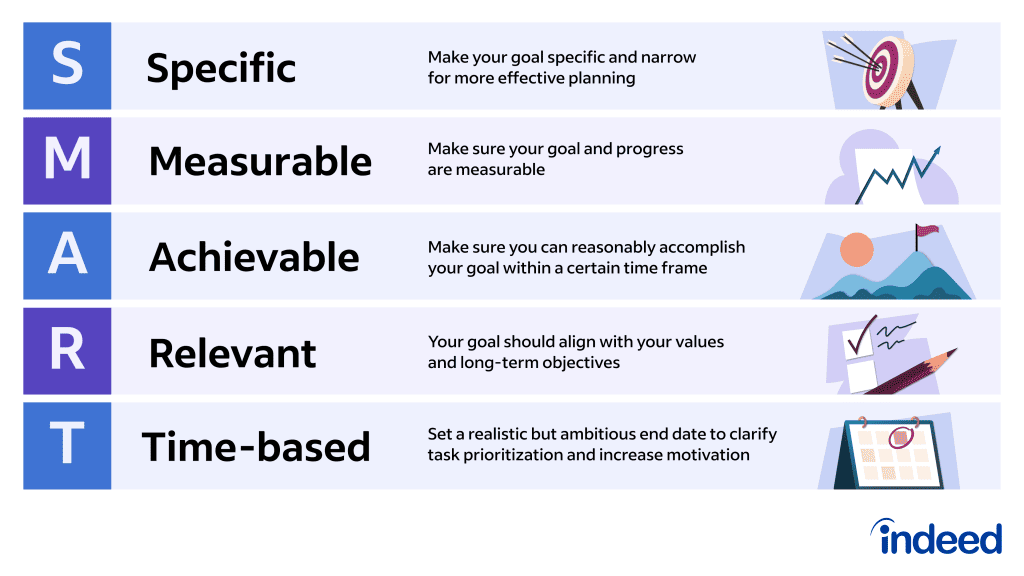
Objectives for personal growth often focus on individual improvement on skills, knowledge, well-being, and overall development.
Personal growth objectives encompass various aspects of life, including emotional, intellectual, physical, and interpersonal dimensions. They serve as roadmaps for continuous learning, growth, and self-awareness.
- Read one non-fiction book each month to expand knowledge in areas of personal interest.
- Incorporate regular exercise into the routine by walking or jogging for at least 30 minutes five times a week.
Tips to write objectives for personal growth from AhaSlides.
💡 Development Goals For Work: A Step-By-Step Guide For Beginners with Examples
💡 What is Personal Growth? Set Up Personal Goals For Work | Updated in 2023
💡 Work Goals Examples For Evaluation with +5 Steps To Create in 2023
How to write objectives in general? Here are common tips for setting objectives of any field.
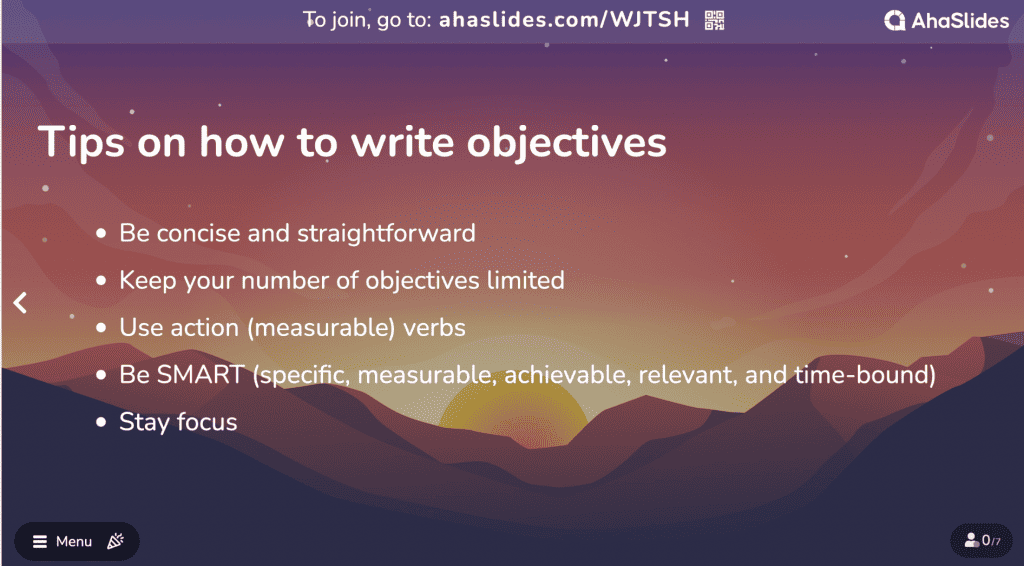
#1. Be concise and straightforward
Keep the words as simple and straightforward as much as possible. It is much better to remove unnecessary or ambiguous words that might lead to misunderstanding.
#2. Keep your number of objectives limited
Don’t confuse your learners or readers with too many objectives. Concentrating on a few key objectives can effectively maintain focus and clarity and prevent overwhelming.
#3. Use action verbs
You can start each objective with one of the following measurable verbs: Describe, Explain, Identify, Discuss, Compare, Define, Differentiate, List, and more.
#4. Be SMART
SMART objectives framework can be defined with specific, measurable, achievable, relevant, and time-bound. These objectives are clearer and easier to understand and achieve.
⭐ Want more inspiration? Check out AhaSlides to explore the innovative way to get presentations and lesson engaging and fun!
What are the 3 parts of an objective?
According to Mager (1997), objective statements contain three parts: behavior (or, performance), conditions, and criteria.
What are the 4 elements of a well-written objective?
The four elements of an objective are Audience, Behavior, Condition, and Degree, called A-B-C-D method. They are used to identify what a student is expected to know and how to test them.
What are the 4 components of objective writing?
There are four components of an objective include: (1) the action verb, (2) conditions, (3) standard, and (4) the intended audience (always the students)
Ref: Indeed | Batchwood |

Astrid Tran
I've got my rhythm with words
More from AhaSlides


- Tips & Tricks
- PowerPoint Templates
- Training Programs
- Free E-Courses
How to set a clear presentation objective
Home > Presentation Outline > Presentation Objective
Ask any presenter, and they will tell you that it is essential to set a presentation objective. However, when asked how to go about setting these objectives, they often draw a blank. The term 'objective' is often used quite casually by many presenters, without fully understanding its importance.

Most presentation objectives tend to sound like this: "I want everyone to appreciate my unique ideas, leave a strong impression on my audience, and make a great presentation." However, these goals are too broad and lack specificity to help a presenter create a presentation that will truly resonate with their audience.
The objectives of a presentation are not vague statements of presenter goals.
They follow a clearly defined structure.
You need to use that structure for setting your objectives because…
A clearly defined presentation objective is the first step to a remarkable presentation.
A clear and meaningful presentation objective determines…
- How confidently you deliver your presentation
- How much your audience trusts your suggestions
- How you prioritize your points and structure your presentation
- How your presentation ends – i.e. whether your presentation ends with polite claps or with a clear decision to address the next steps.
In this article, we will show you Minimal® process for setting up clear objectives for presentation in a step-by-step way.
What is the process for setting the objective?
Setting an objective for your presentation involves answering three essential questions: Who, What, and Why.
- Who is the intended audience?
- What action should they take?
- And why should they take this action? What is in it for them?
Let's delve into each of these questions in turn.
WHO – Who is the last person in your audience?
The last person is the one who must take action based on your presentation. This could be the ultimate decision-maker or someone who has an influence on the decision-making process.
If your presentation is purely informational , such as a training presentation on products, the last person is the one with the least amount of knowledge on the subject.
When crafting your presentation outline or story, it is important to keep the last person in mind in order to ensure that the information is presented in a way that is understandable and engaging.

Why do you need to define the last person for your presentation?
It is to focus your message. The clearer you are about the last person, the more focused your message gets:
- By understanding the knowledge and experience level of the last person, you can plan the extent to which you need to build the context and background.
- By understanding the motivation factors, you can determine the nature of your offer.
- By understanding the preferences, you can decide the extent to which you need to use data and emotions in your presentation.
If you don’t determine the last person, you end up with a vague and boring presentation. Remember, when you want to appeal to everyone, you convince no one.
So, setting a clear presentation objective is the critical first step in creating your presentation.
Your action step
Determine the last person for your presentation. Create a thumbnail profile – like the age, work experience, job responsibilities, awareness levels etc. If possible, get a picture of the last person and stick it in front of you.
This person represents your audience. Check if your presentation would appeal to this person.
Page 2 What is in it for me?
Return to Main Presentation Outline Page
Return to Top of Presentation Objective Page
Share these tips & tutorials
Get 25 creative powerpoint ideas mini course & members-only tips & offers. sign up for free below:.
404 Not found
How to Write Content Objectives in PowerPoint
by Richard Gaughan
Published on 1 Jan 2021
Just about everyone involved in business will eventually have to deliver PowerPoint presentations to colleagues, customers, partners or employees. You will be asking your listeners to give you their time, and they'll want to know if it will be worth their while; that is, what will they get out of their investment in your presentation? Content objectives are your way of providing the answer to that question. When you concisely state your goals from the outset, you help your audience members develop interest and retain the substance of your presentation.
Review your presentation material to cull the primary elements you want your audience members to remember. Prioritization is extremely important, because they will not be able to retain every bit of your message, and saying everything is important is the same as saying nothing is especially important.
Frame your primary points in "How to" language. Your presentation audience is goal-oriented; they want to know how your presentation will help them achieve specific learning objectives. Avoid general phrasing like "learn about import regulations." Your objectives should be framed more along the lines of "how to expedite technology imports."
State your objectives concisely. There's a reason PowerPoint slides are called "visual aids." They are supposed to help your presentation, rather than define your presentation. Short, precise statements will reinforce your statements, frame them in a different way, and increase interest and attentiveness among your audience members.
Creatas/Creatas/Getty Images
Lay out your slides in a visually appealing manner. The primary rule is to keep the slide uncluttered. A good rule is the "4 by 5" rule – no more than four lines or bullet points, and no more than five words per line. If you have a visual image that reinforces your message, that's even better, as you create another path in the audience members' minds — another way for them to remember your material.
Provide a single "unifying objectives" slide that will state how your audience will benefit from your presentation. For example, if you wish to tell your audience that by the end of a presentation they'll know to how perform a few specific tasks, the top line of your unifying objectives slide should be "How to," followed by objectives like "operate our accounting software / produce daily sales reports / calculate margins."
Although you may think your presentation material is appropriate to post on a website or print and distribute, resist the urge to design your presentation material to be read. PowerPoint is a program intended to help you convey a message you are presenting. If you must make it available without your physical presentation, make the information in your slides considerably more detailed.

(704) 928-5783
- Nov 22, 2022
Presentation Objectives That Give You the Edge
Updated: Jan 31, 2023
Presentation Objectives That Give You The Edge
A compelling presentation begins with a clear objective. It takes the audience on a fascinating journey from where they are now to your ultimate destination—your presentation objective. Your objective identifies what you want to accomplish with your presentation in one or two sentences. This is harder than you think. Too many presenters simply open a PowerPoint deck and start creating a presentation before they identify the objective.
To help you create your objective, answer these questions before creating your presentation:
What is the “ why” of your presentation?
Why is this presentation important to your audience? Why will investing time in attending your presentation benefit those who experience it? Why is your content important to the organization? To you? To your manager? Customers? Others?
Take the time to respond to these questions. Be specific. Your responses will help you create a clear, concise and compelling presentation objective.
What do you want the audience to know, feel and do?
There is so much to know! It is important to be specific about what exactly you will include so you resist over-stuffing your presentation and confusing your audience.
A few examples might help:

Know that without additional funding of $22,000, the project will fail.
Know that one of our biggest customers is meeting with a competitor because they need lower pricing.
Know that new FDA regulations require an increase of 20% in time for current lab protocols.
After you identify your " know ," think through how you want your audience to feel and what you want them to do about this. For example (A) you may want them to feel anxious so that they are willing to commit the additional funding. For (B), you may want the audience to feel nervous about losing a customer so that they will agree to providing lower pricing options. For (C), you may want the audience to feel supportive and so they will agree to hiring an intern.
Create your objective (more info here)
Review your answers to the questions above, and then capture your objective in writing. Here are possible objectives for each of the earlier scenarios:
Get commitment for $22,000 in incremental funding by the end of the quarter to keep project Optimus on track.
Get commitment from director of sales to a three-tier pricing proposal for customer Prime.
Get commitment from lab manager to hire an intern by May 15 to handle new workload created by recent FDA regulation changes.
Don’t simply think about your objective: write it down! Your objective is your North Star. Put this on the top of the page where you create your presentation outline. Include your objective in the introduction section in your slide deck. Review each main point to be sure it supports your objective.

Put in the time to answer these questions so that your next presentation will be clear, concise and compelling.
This article comes from our series on presentation coaching from author Susan Garrity Bish's new book, Clear, Concise & Compelling: How to Present to Change Minds and Influence Outcomes. You can learn more about the book here , or purchase it directly from Amazon here.
- Presentations
Recent Posts
How Are We Transforming Scientists Into World-Class Presenters?
18 Presentation Tips You Need Today
How to Establish Presentation Objectives
Got any suggestions?
We want to hear from you! Send us a message and help improve Slidesgo
Top searches
Trending searches

11 templates

teacher appreciation


mother teresa
18 templates

memorial day
12 templates

summer vacation
25 templates

Objectives and Key Results
Objectives and key results presentation, free google slides theme, powerpoint template, and canva presentation template.
In business, OKR means "objectives and key results", a way of defining objectives to meet and tracking their completion. In this template you'll find quite the amount of diagrams, infographics and tables, as you'll need to show lots of data, numbers and percentages. The backgrounds are a bit abstract and the color palette focuses on blue tones, sending the message that everything is under control.
Features of this template
- 100% editable and easy to modify
- 31 different slides to impress your audience
- Contains easy-to-edit graphics such as graphs, maps, tables, timelines and mockups
- Includes 500+ icons and Flaticon’s extension for customizing your slides
- Designed to be used in Google Slides, Canva, and Microsoft PowerPoint
- 16:9 widescreen format suitable for all types of screens
- Includes information about fonts, colors, and credits of the free resources used
How can I use the template?
Am I free to use the templates?
How to attribute?
Attribution required If you are a free user, you must attribute Slidesgo by keeping the slide where the credits appear. How to attribute?
Related posts on our blog.

How to Add, Duplicate, Move, Delete or Hide Slides in Google Slides

How to Change Layouts in PowerPoint

How to Change the Slide Size in Google Slides
Related presentations.

Premium template
Unlock this template and gain unlimited access

Register for free and start editing online

Improve your practice.
Enhance your soft skills with a range of award-winning courses.
How to Structure your Presentation, with Examples
August 3, 2018 - Dom Barnard
For many people the thought of delivering a presentation is a daunting task and brings about a great deal of nerves . However, if you take some time to understand how effective presentations are structured and then apply this structure to your own presentation, you’ll appear much more confident and relaxed.
Here is our complete guide for structuring your presentation, with examples at the end of the article to demonstrate these points.
Why is structuring a presentation so important?
If you’ve ever sat through a great presentation, you’ll have left feeling either inspired or informed on a given topic. This isn’t because the speaker was the most knowledgeable or motivating person in the world. Instead, it’s because they know how to structure presentations – they have crafted their message in a logical and simple way that has allowed the audience can keep up with them and take away key messages.
Research has supported this, with studies showing that audiences retain structured information 40% more accurately than unstructured information.
In fact, not only is structuring a presentation important for the benefit of the audience’s understanding, it’s also important for you as the speaker. A good structure helps you remain calm, stay on topic, and avoid any awkward silences.
What will affect your presentation structure?
Generally speaking, there is a natural flow that any decent presentation will follow which we will go into shortly. However, you should be aware that all presentation structures will be different in their own unique way and this will be due to a number of factors, including:
- Whether you need to deliver any demonstrations
- How knowledgeable the audience already is on the given subject
- How much interaction you want from the audience
- Any time constraints there are for your talk
- What setting you are in
- Your ability to use any kinds of visual assistance
Before choosing the presentation’s structure answer these questions first:
- What is your presentation’s aim?
- Who are the audience?
- What are the main points your audience should remember afterwards?
When reading the points below, think critically about what things may cause your presentation structure to be slightly different. You can add in certain elements and add more focus to certain moments if that works better for your speech.

What is the typical presentation structure?
This is the usual flow of a presentation, which covers all the vital sections and is a good starting point for yours. It allows your audience to easily follow along and sets out a solid structure you can add your content to.
1. Greet the audience and introduce yourself
Before you start delivering your talk, introduce yourself to the audience and clarify who you are and your relevant expertise. This does not need to be long or incredibly detailed, but will help build an immediate relationship between you and the audience. It gives you the chance to briefly clarify your expertise and why you are worth listening to. This will help establish your ethos so the audience will trust you more and think you’re credible.
Read our tips on How to Start a Presentation Effectively
2. Introduction
In the introduction you need to explain the subject and purpose of your presentation whilst gaining the audience’s interest and confidence. It’s sometimes helpful to think of your introduction as funnel-shaped to help filter down your topic:
- Introduce your general topic
- Explain your topic area
- State the issues/challenges in this area you will be exploring
- State your presentation’s purpose – this is the basis of your presentation so ensure that you provide a statement explaining how the topic will be treated, for example, “I will argue that…” or maybe you will “compare”, “analyse”, “evaluate”, “describe” etc.
- Provide a statement of what you’re hoping the outcome of the presentation will be, for example, “I’m hoping this will be provide you with…”
- Show a preview of the organisation of your presentation
In this section also explain:
- The length of the talk.
- Signal whether you want audience interaction – some presenters prefer the audience to ask questions throughout whereas others allocate a specific section for this.
- If it applies, inform the audience whether to take notes or whether you will be providing handouts.
The way you structure your introduction can depend on the amount of time you have been given to present: a sales pitch may consist of a quick presentation so you may begin with your conclusion and then provide the evidence. Conversely, a speaker presenting their idea for change in the world would be better suited to start with the evidence and then conclude what this means for the audience.
Keep in mind that the main aim of the introduction is to grab the audience’s attention and connect with them.
3. The main body of your talk
The main body of your talk needs to meet the promises you made in the introduction. Depending on the nature of your presentation, clearly segment the different topics you will be discussing, and then work your way through them one at a time – it’s important for everything to be organised logically for the audience to fully understand. There are many different ways to organise your main points, such as, by priority, theme, chronologically etc.
- Main points should be addressed one by one with supporting evidence and examples.
- Before moving on to the next point you should provide a mini-summary.
- Links should be clearly stated between ideas and you must make it clear when you’re moving onto the next point.
- Allow time for people to take relevant notes and stick to the topics you have prepared beforehand rather than straying too far off topic.
When planning your presentation write a list of main points you want to make and ask yourself “What I am telling the audience? What should they understand from this?” refining your answers this way will help you produce clear messages.
4. Conclusion
In presentations the conclusion is frequently underdeveloped and lacks purpose which is a shame as it’s the best place to reinforce your messages. Typically, your presentation has a specific goal – that could be to convert a number of the audience members into customers, lead to a certain number of enquiries to make people knowledgeable on specific key points, or to motivate them towards a shared goal.
Regardless of what that goal is, be sure to summarise your main points and their implications. This clarifies the overall purpose of your talk and reinforces your reason for being there.
Follow these steps:
- Signal that it’s nearly the end of your presentation, for example, “As we wrap up/as we wind down the talk…”
- Restate the topic and purpose of your presentation – “In this speech I wanted to compare…”
- Summarise the main points, including their implications and conclusions
- Indicate what is next/a call to action/a thought-provoking takeaway
- Move on to the last section
5. Thank the audience and invite questions
Conclude your talk by thanking the audience for their time and invite them to ask any questions they may have. As mentioned earlier, personal circumstances will affect the structure of your presentation.
Many presenters prefer to make the Q&A session the key part of their talk and try to speed through the main body of the presentation. This is totally fine, but it is still best to focus on delivering some sort of initial presentation to set the tone and topics for discussion in the Q&A.

Other common presentation structures
The above was a description of a basic presentation, here are some more specific presentation layouts:
Demonstration
Use the demonstration structure when you have something useful to show. This is usually used when you want to show how a product works. Steve Jobs frequently used this technique in his presentations.
- Explain why the product is valuable.
- Describe why the product is necessary.
- Explain what problems it can solve for the audience.
- Demonstrate the product to support what you’ve been saying.
- Make suggestions of other things it can do to make the audience curious.
Problem-solution
This structure is particularly useful in persuading the audience.
- Briefly frame the issue.
- Go into the issue in detail showing why it ‘s such a problem. Use logos and pathos for this – the logical and emotional appeals.
- Provide the solution and explain why this would also help the audience.
- Call to action – something you want the audience to do which is straightforward and pertinent to the solution.
Storytelling
As well as incorporating stories in your presentation , you can organise your whole presentation as a story. There are lots of different type of story structures you can use – a popular choice is the monomyth – the hero’s journey. In a monomyth, a hero goes on a difficult journey or takes on a challenge – they move from the familiar into the unknown. After facing obstacles and ultimately succeeding the hero returns home, transformed and with newfound wisdom.
Storytelling for Business Success webinar , where well-know storyteller Javier Bernad shares strategies for crafting compelling narratives.
Another popular choice for using a story to structure your presentation is in media ras (in the middle of thing). In this type of story you launch right into the action by providing a snippet/teaser of what’s happening and then you start explaining the events that led to that event. This is engaging because you’re starting your story at the most exciting part which will make the audience curious – they’ll want to know how you got there.
- Great storytelling: Examples from Alibaba Founder, Jack Ma
Remaining method
The remaining method structure is good for situations where you’re presenting your perspective on a controversial topic which has split people’s opinions.
- Go into the issue in detail showing why it’s such a problem – use logos and pathos.
- Rebut your opponents’ solutions – explain why their solutions could be useful because the audience will see this as fair and will therefore think you’re trustworthy, and then explain why you think these solutions are not valid.
- After you’ve presented all the alternatives provide your solution, the remaining solution. This is very persuasive because it looks like the winning idea, especially with the audience believing that you’re fair and trustworthy.
Transitions
When delivering presentations it’s important for your words and ideas to flow so your audience can understand how everything links together and why it’s all relevant. This can be done using speech transitions which are words and phrases that allow you to smoothly move from one point to another so that your speech flows and your presentation is unified.
Transitions can be one word, a phrase or a full sentence – there are many different forms, here are some examples:
Moving from the introduction to the first point
Signify to the audience that you will now begin discussing the first main point:
- Now that you’re aware of the overview, let’s begin with…
- First, let’s begin with…
- I will first cover…
- My first point covers…
- To get started, let’s look at…
Shifting between similar points
Move from one point to a similar one:
- In the same way…
- Likewise…
- Equally…
- This is similar to…
- Similarly…
Internal summaries
Internal summarising consists of summarising before moving on to the next point. You must inform the audience:
- What part of the presentation you covered – “In the first part of this speech we’ve covered…”
- What the key points were – “Precisely how…”
- How this links in with the overall presentation – “So that’s the context…”
- What you’re moving on to – “Now I’d like to move on to the second part of presentation which looks at…”
Physical movement
You can move your body and your standing location when you transition to another point. The audience find it easier to follow your presentation and movement will increase their interest.
A common technique for incorporating movement into your presentation is to:
- Start your introduction by standing in the centre of the stage.
- For your first point you stand on the left side of the stage.
- You discuss your second point from the centre again.
- You stand on the right side of the stage for your third point.
- The conclusion occurs in the centre.
Key slides for your presentation
Slides are a useful tool for most presentations: they can greatly assist in the delivery of your message and help the audience follow along with what you are saying. Key slides include:
- An intro slide outlining your ideas
- A summary slide with core points to remember
- High quality image slides to supplement what you are saying
There are some presenters who choose not to use slides at all, though this is more of a rarity. Slides can be a powerful tool if used properly, but the problem is that many fail to do just that. Here are some golden rules to follow when using slides in a presentation:
- Don’t over fill them – your slides are there to assist your speech, rather than be the focal point. They should have as little information as possible, to avoid distracting people from your talk.
- A picture says a thousand words – instead of filling a slide with text, instead, focus on one or two images or diagrams to help support and explain the point you are discussing at that time.
- Make them readable – depending on the size of your audience, some may not be able to see small text or images, so make everything large enough to fill the space.
- Don’t rush through slides – give the audience enough time to digest each slide.
Guy Kawasaki, an entrepreneur and author, suggests that slideshows should follow a 10-20-30 rule :
- There should be a maximum of 10 slides – people rarely remember more than one concept afterwards so there’s no point overwhelming them with unnecessary information.
- The presentation should last no longer than 20 minutes as this will leave time for questions and discussion.
- The font size should be a minimum of 30pt because the audience reads faster than you talk so less information on the slides means that there is less chance of the audience being distracted.
Here are some additional resources for slide design:
- 7 design tips for effective, beautiful PowerPoint presentations
- 11 design tips for beautiful presentations
- 10 tips on how to make slides that communicate your idea
Group Presentations
Group presentations are structured in the same way as presentations with one speaker but usually require more rehearsal and practices. Clean transitioning between speakers is very important in producing a presentation that flows well. One way of doing this consists of:
- Briefly recap on what you covered in your section: “So that was a brief introduction on what health anxiety is and how it can affect somebody”
- Introduce the next speaker in the team and explain what they will discuss: “Now Elnaz will talk about the prevalence of health anxiety.”
- Then end by looking at the next speaker, gesturing towards them and saying their name: “Elnaz”.
- The next speaker should acknowledge this with a quick: “Thank you Joe.”
From this example you can see how the different sections of the presentations link which makes it easier for the audience to follow and remain engaged.
Example of great presentation structure and delivery
Having examples of great presentations will help inspire your own structures, here are a few such examples, each unique and inspiring in their own way.
How Google Works – by Eric Schmidt
This presentation by ex-Google CEO Eric Schmidt demonstrates some of the most important lessons he and his team have learnt with regards to working with some of the most talented individuals they hired. The simplistic yet cohesive style of all of the slides is something to be appreciated. They are relatively straightforward, yet add power and clarity to the narrative of the presentation.
Start with why – by Simon Sinek
Since being released in 2009, this presentation has been viewed almost four million times all around the world. The message itself is very powerful, however, it’s not an idea that hasn’t been heard before. What makes this presentation so powerful is the simple message he is getting across, and the straightforward and understandable manner in which he delivers it. Also note that he doesn’t use any slides, just a whiteboard where he creates a simple diagram of his opinion.
The Wisdom of a Third Grade Dropout – by Rick Rigsby
Here’s an example of a presentation given by a relatively unknown individual looking to inspire the next generation of graduates. Rick’s presentation is unique in many ways compared to the two above. Notably, he uses no visual prompts and includes a great deal of humour.
However, what is similar is the structure he uses. He first introduces his message that the wisest man he knew was a third-grade dropout. He then proceeds to deliver his main body of argument, and in the end, concludes with his message. This powerful speech keeps the viewer engaged throughout, through a mixture of heart-warming sentiment, powerful life advice and engaging humour.
As you can see from the examples above, and as it has been expressed throughout, a great presentation structure means analysing the core message of your presentation. Decide on a key message you want to impart the audience with, and then craft an engaging way of delivering it.
By preparing a solid structure, and practising your talk beforehand, you can walk into the presentation with confidence and deliver a meaningful message to an interested audience.
It’s important for a presentation to be well-structured so it can have the most impact on your audience. An unstructured presentation can be difficult to follow and even frustrating to listen to. The heart of your speech are your main points supported by evidence and your transitions should assist the movement between points and clarify how everything is linked.
Research suggests that the audience remember the first and last things you say so your introduction and conclusion are vital for reinforcing your points. Essentially, ensure you spend the time structuring your presentation and addressing all of the sections.
404 Not found
Management Notes

Objective of Presentation – 12 Common Objectives Explained in Detail | Business Communication
Objective of presentation.
A presentation is a fundamental part of human communication, and it is widely used across a variety of fields including education, business, research, and entertainment. A presentation’s primary objective is to provide information, ideas, or concepts to an audience in an engaging, clear, and organized manner.
In this comprehensive article, we examine the multifaceted objectives of presentations and explore how they can be used to inform, educate, persuade, inspire, and solve problems.
We will demonstrate how presentations effectively share knowledge, influence opinions, and facilitate collaboration by providing a detailed analysis.
Some of the common objectives of the presentation are as follows:

Presenters are primarily responsible for providing information about a specific topic, event, project, product, or service to their audience. In order to improve the audience’s understanding of the subject matter, the presenter will provide essential information and relevant details.
Effective information dissemination is essential to the success of any presentation, whether it is a scientific conference, a business proposal, or an educational lecture.
It is important that presenters carefully structure their presentations, ensuring clarity and coherence. Visual aids, such as slides, charts, and graphs, can complement verbal explanations, simplifying complex information.
Moreover, audience interaction, such as Q&A sessions, can reinforce key points and address specific questions, further facilitating effective communication by addressing specific questions.
2. Educate:
Presentations play a vital role in educational settings, as they are often used to teach new concepts, theories, or skills. A well-designed educational presentation can encourage active engagement and improve knowledge retention in classrooms, workshops, or training sessions. It facilitates learning and enhances the audience’s knowledge of a particular subject.
Presenters must adapt their delivery style to accommodate different learning preferences so that their content reflects the audience’s level of understanding and achieves the educational objective. It is easier to solidify concepts and make the learning experience more enjoyable when real-life examples, case studies, and interactive activities are used.
3. Persuade:
A presentation’s objective is to persuade the audience, particularly in business, marketing, or public speaking situations. In order to persuade an audience, the presenter needs to convince them to accept a particular viewpoint, idea, or proposal using logical arguments, emotional appeal, and credibility.
It is important for presenters to understand their audience’s needs, concerns, and motivations when crafting compelling messages. By using storytelling techniques, testimonials, and persuasive language, the audience can be emotionally connected to the ideas presented, making them more receptive.
The presenter’s position can also be reinforced by strong evidence and data-driven arguments.
4. Inspire and Motivate:
A presentation’s objective is usually to motivate or inspire the audience, particularly when leading, giving a public speaking, or building a team. In order to foster a sense of enthusiasm and commitment towards a shared vision or goal, the presenter is expected to inspire and energize the audience.
In order to achieve this goal, presenters must display passion, authenticity, and leadership skills. By sharing personal anecdotes, success stories, and uplifting quotes, presenters can evoke emotions and build a sense of camaraderie among the audience. In addition, presenting a clear vision and a path to achieving it can motivate the audience to act.
5. Report Findings:
Presentations are commonly used to present research findings, project results, financial results, or other critical data in academic and professional settings. Providing structured and visually appealing results facilitates comprehension and discussion by facilitating the presentation of results.
The methodology, findings, and implications of a research or project should be clearly presented in an effective reporting presentation. Charts, graphs, and infographics are excellent visual aids for enhancing data visualization and simplifying complex information. Further exploration and collaboration can also be enhanced by presenting limitations and future directions.
6. Training and Development:
Organizations use presentations to promote learning, skill development, and knowledge transfer, which make them an essential tool for training and development. This presentation aims to provide the audience with the tools and information they need to excel in their job.
An interactive and engaging training session that encourages active participation is crucial to achieving the training objective. Learning and skill application can be reinforced through hands-on exercises, role-playing, and group discussions. Feedback and follow-up resources can ensure continued growth.
7. Entertain:
Entertainment is a primary objective of some presentations, particularly in conferences, seminars, or social gatherings. A presentation’s primary purpose is to entertain the audience and keep them engaged, alleviate boredom, and create an enjoyable experience.
Presenters can use humor, storytelling, and multimedia elements to achieve the entertainment objective. Also, engaging the audience through quizzes, challenges, and audience participation can make the presentation more lively and enjoyable.
8. Problem-Solving:
A presentation can be used to solve problems and identify solutions, especially in business and decision-making contexts. The objective is to engage an audience in finding viable solutions to specific problems.
Before presenting potential solutions, presenters need to clarify the problem and its implications in order to achieve the problem-solving objective. Audiences can be guided through the decision-making process by using a structured approach such as the problem-solving model or SWOT analysis.
By involving the audience in brainstorming or group exercises, valuable insights and innovative solutions can also be gained.
9. Present Updates:
Presentations serve as an opportunity to share information about ongoing projects, company developments, or industry trends in business environments. Their objective is to keep stakeholders informed and engaged.
In order to achieve this objective, presenters must provide accurate and up-to-date information. By proactively addressing potential concerns or challenges, stakeholders can be instilled with confidence and foster transparency. Visual aids like timelines, charts, or trend graphs can help convey progress and future projections.
10. Facilitate Discussion:
A presentation can serve as a basis for group discussion, where the audience actively contributes ideas and perspectives. This promotes dialogue. A presenter must create an inclusive and open environment that encourages audience participation in order to achieve this objective.
It is beneficial to allow for a variety of viewpoints and experiences to be exchanged. Active listening and thoughtful responses from the presenter can enrich the discussion further.
11. Promote Collaboration:
Collaboration: Presentations encourage collaboration between members of a team by sharing ideas, progress, and goals. They encourage people to align efforts for a common goal.
Teamwork and a shared sense of purpose are essential to achieving the collaboration objective. By inviting input and feedback from all team members, the presenter can create a sense of inclusion and ownership. In order for the team’s efforts to be coordinated and productive, clear action plans and follow-up procedures must be established.
12. Showcase Creativity:
A presentation may be used to present innovative ideas, campaigns, or projects in creative fields such as design, art, or marketing. The objective is to impress and engage the audience through creative thinking.
Presenters must think outside the box and use unconventional presentation techniques in order to achieve the creativity objective. The presentation can be memorable and impactful if it incorporates multimedia elements, interactive experiences, or live demonstrations.
In addition, audience members can gain a deeper understanding of the project’s conception by providing context and explaining the creative process.
A well-organized and delivered presentation can accomplish its objectives effectively, leaving a lasting impression on the audience and fulfilling the presenter’s objectives.
Related Posts
- Social Media PPT – Key Aspects of Social Media | Powerpint Presentation and Explanation
- Oral Presentation – 6 Ps of Presentation | Business Communication Notes
- Recent Posts
- Frito Lay SWOT Analysis – Strengths, Weaknesses, Opportunities & Threats | SWOT Analysis - January 11, 2024
- Fox News SWOT Analysis – Strengths, Weaknesses, Opportunities & Threats | SWOT Analysis - January 5, 2024
- Freshly SWOT Analysis – Strengths, Weaknesses, Opportunities & Threats | SWOT Analysis - January 4, 2024
Share this:
Leave a comment cancel reply.
Notify me of follow-up comments by email.
Notify me of new posts by email.

What is a Presentation? Objectives, Elements, Important skills, Four Ps
- Post last modified: 4 June 2023
- Reading time: 19 mins read
- Post category: Business Communication

What is a Presentation?
A presentation communicates a message, an idea or information to a group. It is similar to a report, but with a key difference–the human element. A presentation conveys the speaker’s personality and enables immediate interaction among all participants.
Table of Content
- 1 What is a Presentation?
- 2.1 To Inform
- 2.2 To Train
- 2.3 To Persuade
- 2.4 To Motivate
- 2.5 To Entertain
- 3 Main Elements of Presentation
- 4.1 Analytical ability
- 4.2 Effective communication ability
- 4.3 Creative ability
- 4.4 Good interpersonal skill
- 4.5 Sound time management
- 4.6 Problem-solving ability
- 4.7 A sense of humour
- 5 Evaluation Wheel
- 6.1 Prepare
- 6.2 Practice
- 6.3 Present
- 7.1 Know Yourself
- 7.2 Know Your Material
- 7.3 Know Your Purpose
- 7.4 Know Your Audience
Objectives of Presentation
The main objectives of a presentation are:
To Persuade
To motivate, to entertain.
A presentation is created to convey some information to a group of people. For example, a presentation may display an organisation’s quarterly performance.
Most training programmes in organisations are done through the presentation mode. Such instructional presentations convey a lot of information and are created with instructional design principles to keep the audience engaged for a long period.
Some presentations are used to convince a group of people to accept a particular idea and/or make a certain choice.
The growing popularity of TED Talks indicates how a presentation can be a powerful motivation tool. These presentations trigger emotions and inspire people to act.
Presentations can also be used to celebrate an event. For example, a farewell presentation of a colleague can be used to narrate the story of his/her overall tenure, experiences and achievement in the organisation.
Main Elements of Presentation
A presentation is said to be effective if it has three main elements, which are as follows:
- Specific content : This refers to the information that a presentation will comprise. The information must be conveyed effectively so that it is absorbed by the audience in one sitting. It should be relevant and meaningful to them.
- Audience : A presentation should be targeted for a specific group of audience who share the same purpose and have a similar level of pre-knowledge.
- Presenter: The presenter should act as the advocate of the information. If his/her conviction and passion in the message are clearly articulated, the audience will also pay attention to the subject.
Important Presentation Skills
In today’s business environment, presentation skills are requisite in almost every professional arena. Employees are often required to give presentations on the targets achieved by them. A presentation can be effective if it is carefully planned and prepared.
However, delivering presentations is not always easy for every individual. Some people take presenting as a probable opportunity to showcase skills, while others find it a challenging task. To provide an effective presentation, a presenter must possess some abilities.
Some of them are explained as follows:
Analytical ability
Effective communication ability, creative ability, good interpersonal skill, sound time management, problem-solving ability, a sense of humour.
It refers to a calibre which empowers an individual to collect, organise, visualise and comprehend data. Such skills enable a person to look at related patterns, draw conclusions and find solutions to problems. In addition, sound analytical skills also enable an individual to forecast future trends using various techniques such as brainstorming, forecasting, data mining and metrics interpretation.
Communication entails much more than mere talking to the audience. To communicate effectively during a presentation, one ought to showcase information lucidly. During a presentation, a person should not just have a good set of slides together; rather he needs to engage and strike a chord with the audience to transmit the intended message.
It refers to the ability to present things in a creative way that have not been explored earlier. Creative skills in presentation enable an individual to invent or develop something path-breaking, such as a new concept, unique way out from a problem, a method, a work of art or new machinery, etc.
It encompasses how an individual portrays or presents himself to the audience and builds a rapport with the audience. During a presentation, sound interpersonal skills empower a speaker to interact, communicate and collaborate with the audience effectively.
Interpersonal skills are prevalent across all personal and professional interactions between people. Interpersonal skills entail empathy, active listening and emotional intelligence.
While delivering a presentation, a person should manage time effectively, set a presentation schedule and end a presentation within a stipulated time. If a presentation is long, there are chances the audience may lose interest and the message may not be delivered.
A speaker cannot expect audience to actively listen to the presentation for hours. At the start of presentation, a speaker should aim to grab audience’s attention and allocate time for questions and answers at the end.
Problem-solving is a requisite skill for a presentation. During a presentation, the audience may ask the speaker any kind of questions. On the other hand, it is important for the speaker to provide an appropriate answer to the audience to make the presentation successful.
A sense of humour is crucial to deliver a quality presentation to make the environment light and engaging. Appropriate usage of light jokes relieves stress and holds the attention of an audience, which makes the presentation a memorable experience for both the speaker and the audience.
Evaluation Wheel
Evaluation wheel is a creative and effective tool that accumulates information on outcomes in a simple and accessible manner. A presenter can opt for the evaluation wheel tool to show the outcomes of the research or reports. This tool is used to provide various types of information and journeys of change within the organisation.
It offers a visual representation of progression and results in the form of a spider diagram. The evaluation wheel measures the exact outcomes for a programme at the start and end. It also helps educators, designers to comprehend information systematically. Figure shows an example of evaluation wheel:
Figure states the scale questionnaire in a circle form wherein respondents will analyse the instances from their discretion and experience and give rating on a scale of 1 to 5.
For instance, service users are appropriately involved. In this case, if the respondent strongly agrees, he/she will give 5 rating and if he/she does not agree, he/she will give 1 rating. The centre of the circle is for 1 and as the respondent agrees, they reach out to edge for 5 rating.
Ps of Presentation
Even the most powerful presentation may fail if the presenter comes unprepared. A presentation is both a mental and a physical effort. There are Ps of presentation that provide a checklist to the presenter for ensuring that the presentation is well-constructed and clear so that the audience gets the message. These four Ps are explained as follows:
A thoroughly prepared presentation captivates the interests of the audience. The topic or content of the presentation must be thoroughly researched. No one would develop interest in a vague or equivocal presentation. A speaker can make use of stories or relatable examples and quote references to give more depth to the presentation and make it intriguing.
Apart from that, it should be ensured that only important points are highlighted in bullets or using other graphical elements. Providing too much of theory or full sentences can create boredom for the audience.
While preparing for a presentation, the presenter should include the following sections:
- Introduction : This section includes the name of the topic and the purpose of the presentation.
- Body : This section contains the main content of the presentation; thus, it must be prepared in a well-organised manner.
- Summary : It provides a recap of the content of the presentation. It outlines the most important points of the presentation to ensure the key message is retained by the audience.
Practice will make a man perfect is an adage that is appropriate across all spheres of life. It helps a speaker become familiar with his/her own voice, words and phrases and adjust accordingly. By practising thoroughly, a speaker can explore how to fit different pieces of information together and practise transition.
Also, a speaker should make notes wherever required as a part of presentation support. Using an index card is a common form of note-taking that provides a quick glimpse of important points.
While delivering a presentation, the speaker needs to demonstrate confidence in front of the audience. The speaker must be polite, but not apologetic in situations, such as if the session is running overtime or the microphone has stopped working.
Instead he/she should expect and ask for discipline and attention. It is important for a speaker to engage with the audience during the presentation in order to assure them that he/she is genuinely interested in talking to them. 4. Pace, pitch and pause: A presenter should deliver the presentation in an easy-to-follow pace and try changing the pace to enliven the presentation.
For example, pauses can be taken intentionally between main points to reinforce them. Along with pace, pitch is equally important. Just as pace varies in normal conversations, it should be used effectively during presentations too. For example, when asking a question, the presenter can raise the pitch and can lower it down when explaining a point.
Four Cornerstones of Making Memorable Presentations
The most crucial aspect of delivering an effective presentation is that the speaker should appear confident and the speech should look effortless. Presentations are a source of anxiety for many individuals. However, getting well-prepared before delivering a presentation can reduce this feeling considerably and ease apprehension.
There are a number of ways to overcome feelings of anxiety, stress and stage fright before the presentation in order to appear confident in front of the audience. The four cornerstones of making a memorable presentation are provided in the upcoming sections.
Know Yourself
Know your material, know your purpose, know your audience.
A presenter should acknowledge his/her strengths and weaknesses. Accordingly, he/she should decide the style of delivering a presentation. For instance, if a presenter has a great sense of humour and can use it comfortably in the speech, he/she can make the presentation more engaging and interesting.
On the other hand, if the speaker who is an introvert and prefers to talk or engage less, he/she can add visuals in the presentation. Therefore, the trick is whosoever is delivering the presentation should feel comfortable.
Knowing the topic thoroughly is the most important step in preparing and delivering a presentation. A presenter with well-versed knowledge of the topic is bound to feel more confident. One should perform extensive research of the topic using credible websites and surveys.
A presenter with minimal information about the topic will not be able to deliver a memorable presentation; rather, it would create a negative image in front of the audience. A good presentation is one that is centred around the main theme, presents relevant information and stimulates thought.
It is crucial to know the purpose of the presentation. A presenter should be aware of whether the purpose is to create awareness or to build new skills or to change attitudes. For instance, professional firms or businesses use presentations for various purposes such as to create awareness, educate, motivate and persuade internal and external audiences.
Therefore, to prepare a presentation, identify its objective/purpose, determine the method of delivery, formulate a structure, include visual aids and rehearse.
One should know the type of audience and what is their purpose of attending the presentation. For instance, whether they are there for gaining knowledge or learning new skills, etc. The age, culture and knowledge base of the audience help a presenter in designing and delivering his/her presentation effectively and in a manner in which audience can easily understand and relate to.
A well-designed presentation uses visual aids effectively to reinforce the main points and enhance the audience’s level of understanding.
Business Communication Notes
( Click on Topic to Read )
- What is Business Communication?
- What is Communication?
- Types of Communication
7 C of Communication
- Barriers To Business Communication
- Oral Communication
- Types Of Non Verbal Communication
- What is Written Communication?
- What are Soft Skills?
- Interpersonal vs Intrapersonal communication
- Barriers to Communication
- Importance of Communication Skills
- Listening in Communication
- Causes of Miscommunication
- What is Johari Window?
- What is Presentation?
- Communication Styles
- Channels of Communication
- Hofstede’s Dimensions of Cultural Differences and Benett’s Stages of Intercultural Sensitivity
Organisational Communication
- Horizontal C ommunication
- Grapevine Communication
- Downward Communication
- Verbal Communication Skills
- Upward Communication
- Flow of Communication
- What is Emotional Intelligence?
- What is Public Speaking?
- Upward vs Downward Communication
- Internal vs External Communication
- What is Group Discussion?
- What is Interview?
- What is Negotiation?
- What is Digital Communication?
- What is Letter Writing?
Resume and Covering Letter
- What is Report Writing?
- What is Business Meeting?
- What is Public Relations?
- What Is Market Segmentation?
- What Is Marketing Mix?
- Marketing Concept
- Marketing Management Process
- What Is Marketing Environment?
- What Is Consumer Behaviour?
- Business Buyer Behaviour
- Demand Forecasting
- 7 Stages Of New Product Development
- Methods Of Pricing
- What Is Public Relations?
- What Is Marketing Management?
- What Is Sales Promotion?
- Types Of Sales Promotion
- Techniques Of Sales Promotion
- What Is Personal Selling?
- What Is Advertising?
- Market Entry Strategy
- What Is Marketing Planning?
- Segmentation Targeting And Positioning
- Brand Building Process
- Kotler Five Product Level Model
- Classification Of Products
- Types Of Logistics
- What Is Consumer Research?
- What Is DAGMAR?
- Consumer Behaviour Models
- What Is Green Marketing?
- What Is Electronic Commerce?
- Agricultural Cooperative Marketing
- What Is Marketing Control?
- What Is Marketing Communication?
- What Is Pricing?
- Models Of Communication
- What is Sales Management?
- Objectives of Sales Management
- Responsibilities and Skills of Sales Manager
- Theories of Personal Selling
- What is Sales Forecasting?
- Methods of Sales Forecasting
- Purpose of Sales Budgeting
- Methods of Sales Budgeting
- Types of Sales Budgeting
- Sales Budgeting Process
- What is Sales Quotas?
- What is Selling by Objectives (SBO) ?
- What is Sales Organisation?
- Types of Sales Force Structure
- Recruiting and Selecting Sales Personnel
- Training and Development of Salesforce
- Compensating the Sales Force
- Time and Territory Management
- What Is Logistics?
- What Is Logistics System?
- Technologies in Logistics
- What Is Distribution Management?
- What Is Marketing Intermediaries?
- Conventional Distribution System
- Functions of Distribution Channels
- What is Channel Design?
- Types of Wholesalers and Retailers
- What is Vertical Marketing Systems?
- What i s Marketing?
- What i s A BCG Matrix?
- 5 M’S Of Advertising
- What i s Direct Marketing?
- Marketing Mix For Services
- What Market Intelligence System?
- What i s Trade Union?
- What Is International Marketing?
- World Trade Organization (WTO)
- What i s International Marketing Research?
- What is Exporting?
- What is Licensing?
- What is Franchising?
- What is Joint Venture?
- What is Turnkey Projects?
- What is Management Contracts?
- What is Foreign Direct Investment?
- Factors That Influence Entry Mode Choice In Foreign Markets
- What is Price Escalations?
- What is Transfer Pricing?
- Integrated Marketing Communication (IMC)
- What is Promotion Mix?
- Factors Affecting Promotion Mix
- Functions & Role Of Advertising
- What is Database Marketing?
- What is Advertising Budget?
- What is Advertising Agency?
- What is Market Intelligence?
- What is Industrial Marketing?
- What is Customer Value
- What is Consumer Behaviour?
- What Is Personality?
- What Is Perception?
- What Is Learning?
- What Is Attitude?
- What Is Motivation?
- Consumer Imagery
- Consumer Attitude Formation
- What Is Culture?
- Consumer Decision Making Process
- Applications of Consumer Behaviour in Marketing
- Motivational Research
- Theoretical Approaches to Study of Consumer Behaviour
- Consumer Involvement
- Consumer Lifestyle
- Theories of Personality
- Outlet Selection
- Organizational Buying Behaviour
- Reference Groups
- Consumer Protection Act, 1986
- Diffusion of Innovation
- Opinion Leaders
- What is Business Law?
- Indian Contract Act 1872
- Essential Elements of a Valid Contract
- Types of Contract
- What is Discharge of Contract?
- Performance of Contract
- Sales of Goods Act 1930
- Goods & Price: Contract of Sale
- Conditions and Warranties
- Doctrine of Caveat Emptor
- Transfer of Property
- Rights of Unpaid Seller
- Negotiable Instruments Act 1881
- Types of Negotiable Instruments
- Types of Endorsement
- What is Promissory Note?
- What is Cheque?
- What is Crossing of Cheque?
- What is Bill of Exchange?
- What is Offer?
- Limited Liability Partnership Act 2008
- Memorandum of Association
- Articles of Association
- What is Director?
- Trade Unions Act, 1926
- Industrial Disputes Act 1947
- Employee State Insurance Act 1948
- Payment of Wages Act 1936
- Payment of Bonus Act 1965
- Labour Law in India
- What is Brand Management?
- 4 Steps of Strategic Brand Management Process
- Customer Based Brand Equity
- What is Brand Equity?
You Might Also Like

What is Johari Window? Model
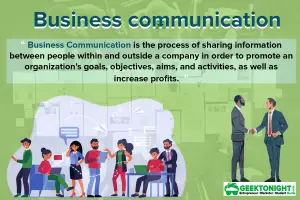
What is Business Communication? Process, Types, Importance, Barriers

What is Upward Communication? Advantages, Disadvantages
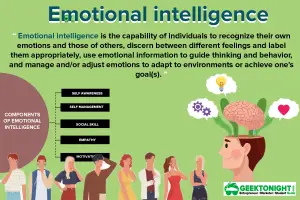
Emotional Intelligence
What is negotiation importance, process, strategic model, learning skills.
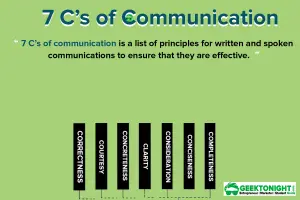
What is Downward Communication? Advantages, Disadvantages

10 Verbal Communication Skills Worth Mastering
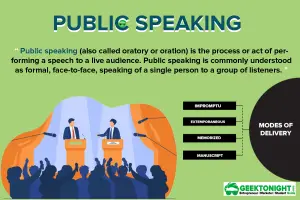
What is Public Speaking? Characteristics, Techniques, Importance, Modes, Checklist
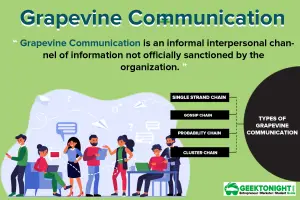
What is Grapevine Communication? Types, Advantages
Leave a reply cancel reply.
You must be logged in to post a comment.
World's Best Online Courses at One Place
We’ve spent the time in finding, so you can spend your time in learning
Digital Marketing
Personal growth.

Development
- Computer Vision
- Federated Learning
- Reinforcement Learning
- Natural Language Processing
- New Releases
- AI Dev Tools
- Advisory Board Members
- 🐝 Partnership and Promotion

Dhanshree Shripad Shenwai
Dhanshree Shenwai is a Computer Science Engineer and has a good experience in FinTech companies covering Financial, Cards & Payments and Banking domain with keen interest in applications of AI. She is enthusiastic about exploring new technologies and advancements in today’s evolving world making everyone's life easy.
- Dhanshree Shripad Shenwai https://www.marktechpost.com/author/dhanshree0078/ Hugging Face Introduces the Open Leaderboard for Hebrew LLMs
- Dhanshree Shripad Shenwai https://www.marktechpost.com/author/dhanshree0078/ Microsoft AI Research Introduces SIGMA: An Open-Source Research Platform to Enable Research and Innovation at the Intersection of Mixed Reality and AI
- Dhanshree Shripad Shenwai https://www.marktechpost.com/author/dhanshree0078/ Top AI Tools for Fashion Designers in 2024
- Dhanshree Shripad Shenwai https://www.marktechpost.com/author/dhanshree0078/ Researchers at Kassel University Introduce a Machine Learning Approach Presenting Specific Target Topologies (Tts) as Actions
RELATED ARTICLES MORE FROM AUTHOR
This ai paper by microsoft and tsinghua university introduces yoco: a decoder-decoder architectures for language models, anthropic ai launches a prompt engineering tool that generates production-ready prompts in the anthropic console, a survey report on new strategies to mitigate hallucination in multimodal large language models, top low/no code ai tools 2024, meet stylemamba: a state space model for efficient text-driven image style transfer, redundancy in ai: a hybrid convolutional neural networks cnn approach to minimize computational overhead in reliable execution, this ai paper by microsoft and tsinghua university introduces yoco: a decoder-decoder architectures for..., anthropic ai launches a prompt engineering tool that generates production-ready prompts in the anthropic..., redundancy in ai: a hybrid convolutional neural networks cnn approach to minimize computational overhead..., collage: a new machine learning approach to deal with floating-point errors in low-precision to..., towards autonomous software development: the swe-agent revolution, top 40+ generative ai tools in 2024, top antidetect browsers in 2024.
- AI Magazine
- Privacy & TC
- Cookie Policy
🐝 🐝 Join the Fastest Growing AI Research Newsletter Read by Researchers from Google + NVIDIA + Meta + Stanford + MIT + Microsoft and many others...
Thank You 🙌
Privacy Overview
Home Business Idea Presentation Template for PowerPoint Goals & Objectives Slide Design for PowerPoint
Goals & Objectives Slide Design for PowerPoint
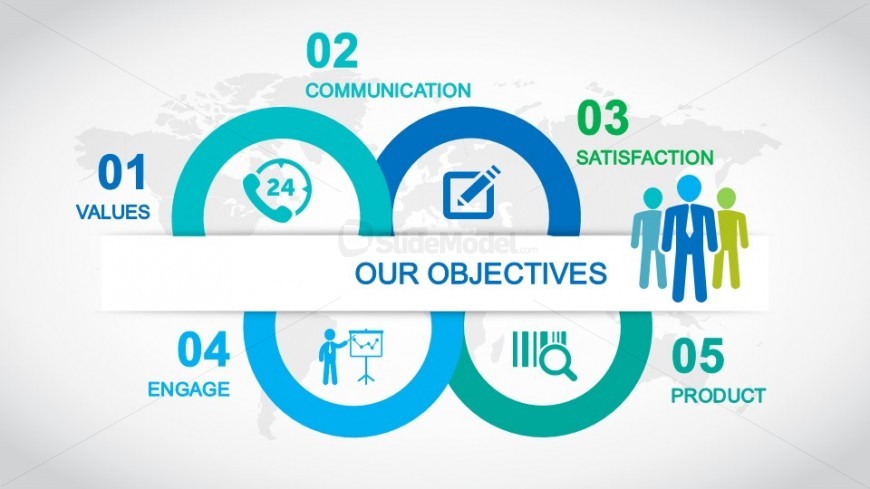
The Office template contains a goals and objectives slide design for PowerPoint which may be utilized in the presentation of marketing and business plans with five major objectives. This specific PowerPoint slide may be used as an overview slide so as to give the audience a better understanding of the main goals so other projects may be made to meet them.
The PowerPoint design features a ribbon which spans the width of the slide design. Found on this ribbon is a PowerPoint graphic of three office workers highlighted in cyan, blue, and yellow green. The ribbon also contains a text placeholder labeled “our objectives”. Four semi-circles are to be found connected to the ribbon. These PowerPoint shapes have different colors which range different shades of blue and cyan, and have corresponding labels, such as numbers from one to five and words such as “values”, “communication,” and “satisfaction.” These also contain generic icons such as a phone and a barcode. In the presentation background is a watermark of the world map, indicating that this PowerPoint template is most suitable for use in international, or global, operations. All PowerPoint objects are 100% customizable to suit the presenter’s needs and preferences.
Return to Business Idea Presentation Template for PowerPoint .
Download unlimited PowerPoint templates, charts and graphics for your presentations with our annual plan.
Slide Tags:
Template tags:, related slides.
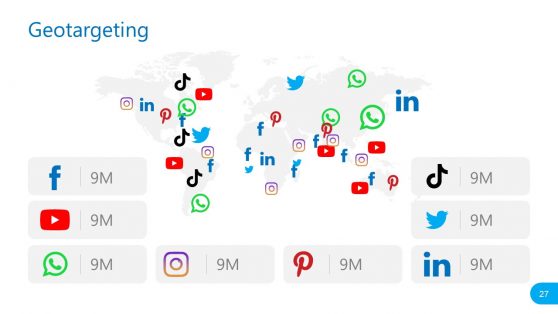
Geotargeting Report of Social Media in PowerPoint
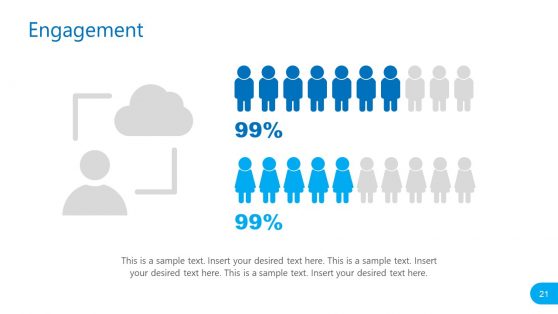
Social Media Engagement Report PowerPoint
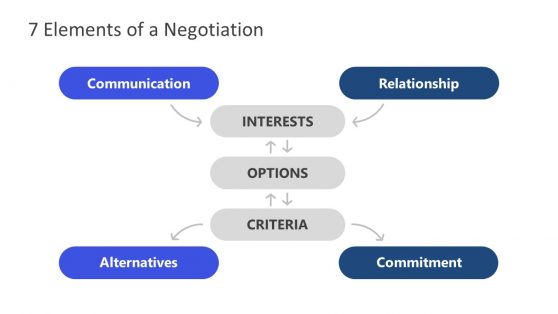
7 Elements of Negotiation PowerPoint
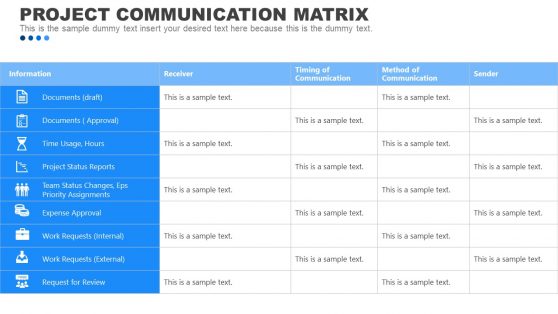
Project Communication Matrix Template
Download unlimited content, our annual unlimited plan let you download unlimited content from slidemodel. save hours of manual work and use awesome slide designs in your next presentation..

IMAGES
VIDEO
COMMENTS
Step 4: Replicate and Modify. Group up the elements that make up your first objective (the icon, heading, and text) and duplicate it. Keep duplicating until you have enough elements to capture your message in full. For example, if you have three objectives, then duplicate your first objective twice.
Template 7 - Smart objectives slide. Create and achieve SMART objectives with this slide. Objectives must be specific, meaning that your goals must be clear. Second, they must be achievable. That is, your goals must be attainable within a clearly defined timespan. Your goals must also be relevant to your business or company and time-bound.
Step 1: Define Your Objectives. The first step in creating an objectives slide is to clarify your objectives. What are the key points you want to convey to your audience? Remember, objectives should be specific, measurable, achievable, relevant, and time-bound ( SMART Goals ). This ensures that your presentation has a clear purpose that is both ...
Step 3: Write your objectives in a clear, concise manner. Articulate your content objectives in a way that is easy to understand and remember. The way you write your objectives can make a big difference. They should be brief, to the point, and devoid of any jargon that might confuse your audience. Think of them as signposts along the road ...
Concentrating on a few key objectives can effectively maintain focus and clarity and prevent overwhelming. #3. Use action verbs. You can start each objective with one of the following measurable verbs: Describe, Explain, Identify, Discuss, Compare, Define, Differentiate, List, and more.
Teachers can easily connect with their students about the expected outcome of the course and learning objective examples by using this best PPT template. Explain the expectations for the course, the content that will be shared, the main learning objectives, and the required materials. Use This Template. 4.
A clearly defined presentation objective is the first step to a remarkable presentation. A clear and meaningful presentation objective determines…. How confidently you deliver your presentation. How much your audience trusts your suggestions. How you prioritize your points and structure your presentation.
Realize that a dull objectives slip will set your entire presentation up for failure. The way I see it, the objectives slide is arguably the most important an of the lot. Yeah, it's honest. Think over it: this slide is going up be among which start things your audience is going to engage for.
In this video, I'm going to teach you how to create goals, objectives, targets, and mission slide design in powerpoint presentation | powerpoint show. smart ...
To make your objectives creative, you can use storytelling, metaphors, humor, and visuals. For example, you can start with a personal anecdote or a case study to illustrate your objectives. You ...
State your objectives concisely. There's a reason PowerPoint slides are called "visual aids." They are supposed to help your presentation, rather than define your presentation. Short, precise statements will reinforce your statements, frame them in a different way, and increase interest and attentiveness among your audience members.
Number of slides: 20. Signup Free to download. A corporate PowerPoint template to set short and long-term objectives for the success of your project or business. This set of 20 white-and-blue slides features creative timelines, circle diagrams, and text slides to help you showcase your objectives at all stages.
Follow these three steps to clearly define your narrative before you start creating your slides. 1. Create an outline. Use a storytelling framework that translates your key message into a ...
Presentation Objectives That Give You The Edge. A compelling presentation begins with a clear objective. It takes the audience on a fascinating journey from where they are now to your ultimate destination—your presentation objective. Your objective identifies what you want to accomplish with your presentation in one or two sentences.
The Objective Slide PowerPoint template is a powerful tool that can assist you in presenting your organization or project's objectives clearly and concisely. The template's modern design provides a professional look that will impress your audience, making it an excellent option for showcasing your objectives. This template includes slides ...
Free Google Slides theme, PowerPoint template, and Canva presentation template. In business, OKR means "objectives and key results", a way of defining objectives to meet and tracking their completion. In this template you'll find quite the amount of diagrams, infographics and tables, as you'll need to show lots of data, numbers and percentages.
This Simple Objective Slide Template for PowerPoint has four slide versions. These slides have a similar two-segment structure, i.e., one text box for presentation points and a creative target icon. This target diagram has a stripped design and exhibits different combinations on the slides. For instance, the first slide has a white & red color ...
This clarifies the overall purpose of your talk and reinforces your reason for being there. Follow these steps: Signal that it's nearly the end of your presentation, for example, "As we wrap up/as we wind down the talk…". Restate the topic and purpose of your presentation - "In this speech I wanted to compare…". 5.
These templates can also be used in Google Slides and Canva, providing you with flexibility and convenience. Designed for professionals and students alike, these templates are perfect for presenting project objectives, business plans, or academic goals. Don't settle for a mediocre presentation - make your objectives shine with these templates.
Step 2: Select a Suitable Layout for the Objectives Slide. PowerPoint offers a range of layout options matching forward into objectives slide. If they have numerous objectives, you might want to use a bulleted list or a grid plan. Alternatively, fork smaller objectives, you might consider using a PowerPoint graphic, such as a key chart or ...
3. Persuade: A presentation's objective is to persuade the audience, particularly in business, marketing, or public speaking situations. In order to persuade an audience, the presenter needs to convince them to accept a particular viewpoint, idea, or proposal using logical arguments, emotional appeal, and credibility.
As an example, I customized the slide with key objectives. In my case, I opted to remove the icons and simplify the "timeline" to just four key pillars. This brings more focus to the slide. I simplified the objective problem statement slide to include my key points. Remember that every slide in our presentation is totally customizable.
A presentation can be effective if it is carefully planned and prepared. However, delivering presentations is not always easy for every individual. Some people take presenting as a probable opportunity to showcase skills, while others find it a challenging task. To provide an effective presentation, a presenter must possess some abilities.
Presentation Title Presenting Gillings 2024 Schoolwide Award Winners! May 1, 2024. STEPHEN COLE, PHD PROFESSOR DEPARTMENT OF EPIDEMIOLOGY Mentoring students is a community-wide task. So, I accept this award on behalf of all of us. John E. Larsh, Jr. Award for Mentorship. JOSEPH G. IBRAHIM, PHD
Association of Bay Area Governments. Bay Area Metro Center 375 Beale Street, Suite 800 San Francisco, CA 94105-2066. Phone: 415-820-7900 Fax: 415-660-3500 Email: [email protected]
The following slide deck was published by Superior Group of Companies, Inc. ... Earnings Call Presentation. May 07, 2024 6:45 PM ET Superior Group of Companies, Inc. (SGC) Stock. SA Transcripts.
Slides AI makes creating presentations easier. Users input the text they wish to use into the system. Slides AI's smart algorithms examine and arrange this text aesthetically, which serves as the presentation's basis. Thanks to this revolutionary method, users may concentrate on content quality rather than design complexity, boosting ...
The following slide deck was published by Clear Channel Outdoor Holdings, Inc. ... Earnings Call Presentation. May 10, 2024 1:32 AM ET Clear Channel Outdoor Holdings, Inc. (CCO) Stock. SA Transcripts.
The following slide deck was published by Mayville Engineering Company, Inc. ... Earnings Call Presentation. May 09, 2024 12:50 PM ET Mayville Engineering Company, Inc. (MEC) Stock. SA Transcripts.
Goals & Objectives Slide Design for PowerPoint. The Office template contains a goals and objectives slide design for PowerPoint which may be utilized in the presentation of marketing and business plans with five major objectives. This specific PowerPoint slide may be used as an overview slide so as to give the audience a better understanding of ...